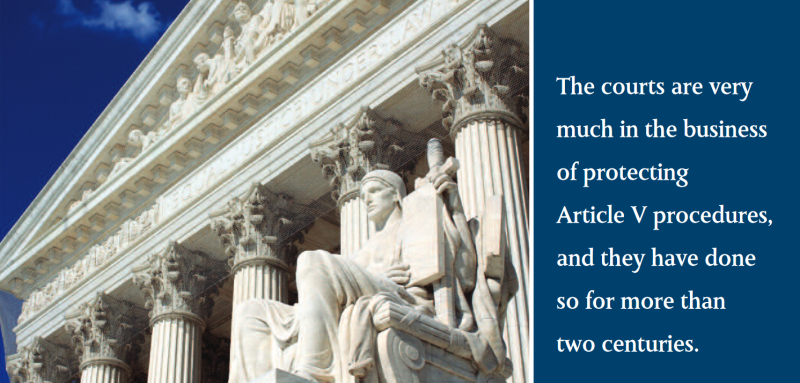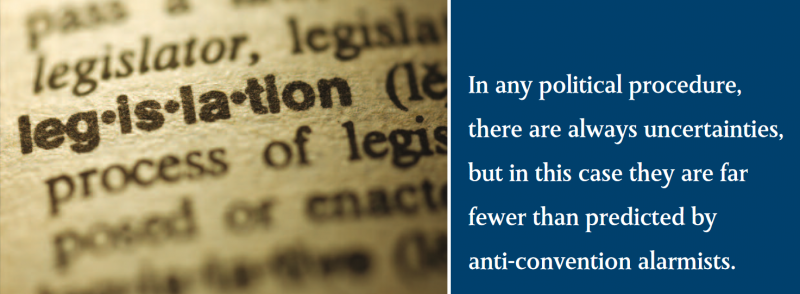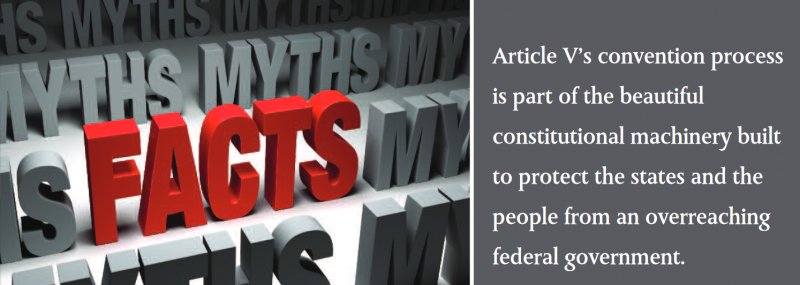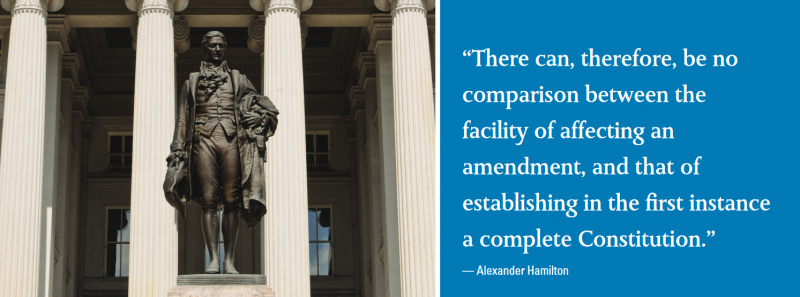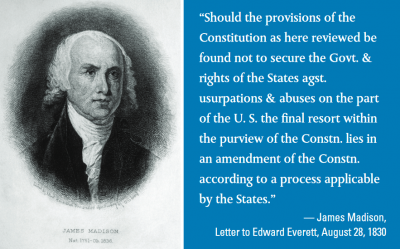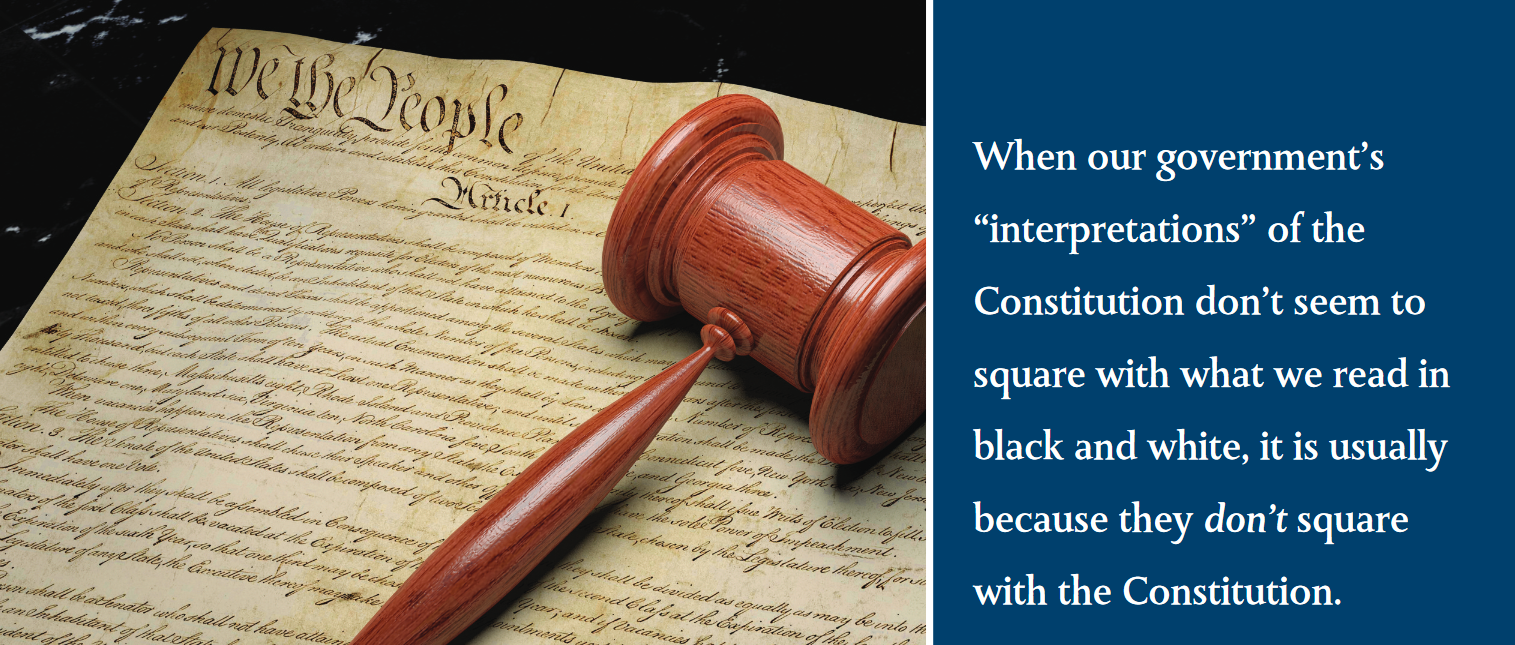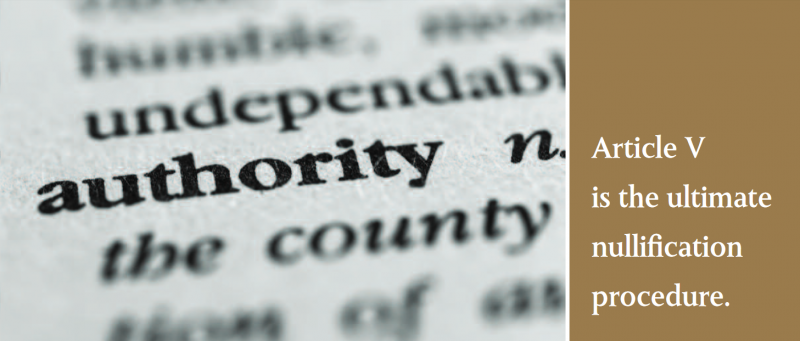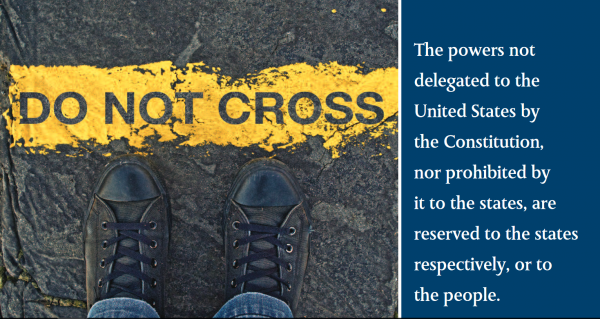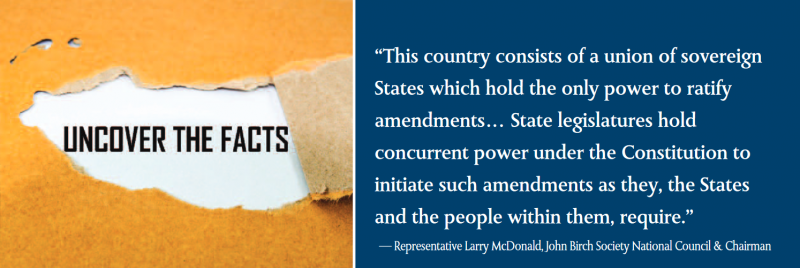Table of Contents
All Surge Documents in one page
(slow load, ~86 pages)
Article 1-Solution As Big As Problem
A Solution As Big As The Problem
Michael P. Farris, JD, LLM, Convention of States Action — Senior Fellow for Constitutional Studies
We See Four Major Abuses Perpetrated by the Federal Government.
These abuses are not mere instances of bad policy. They are driving us towards an age of “soft tyranny” in which the government does not shatter men’s wills but “softens, bends, and guides” them. If we do nothing to halt these abuses, we run the risk of becoming nothing more than “a flock of timid and industrious animals, of which the government is the shepherd.”
(Alexis de Tocqueville, Democracy in America,1840)
1. The Spending and Debt Crisis
The $17 trillion national debt is staggering, but it only tells part of the story. Under standard accounting practices, the federal government owes around $100 trillion more in vested Social Security benefits and other pro-grams. This is why the government cannot tax its way out of debt. Even if it confiscated everything, it would not cover the debt.
2. The Regulatory Crisis
The federal bureaucracy has placed a regulatory burden upon businesses that is complex, conflicted, and crushing. Little account-ability exists when agencies—rather than Congress—enact the real substance of the law. Research from the American Enterprise Institute shows that, since 1949, federal regulations have lowered the real GDP growth by 2% and made America 72% poorer.
3. Congressional Attacks on State Sovereignty
For years, Congress has been using federal grants to keep the states under its control. Combining these grants with federal mandates (which are rarely fully funded), Congress has turned state legislatures into their regional agencies rather than respecting them as truly independent republican governments.
A radical social agenda and an invasion of the rights of the people accompany all of this. While significant efforts have been made to combat this social erosion, these trends defy some of the most important principles.
4. Federal Takeover of the Decision-Making Process
The Founders believed that the structures of a limited government would provide the greatest protection of liberty. Not only were there to be checks and balances between the branches of the federal government, but power was to be shared between the states and federal government, with the latter only exercising those powers specifically granted in the Constitution.
Collusion among decision-makers in Washington, D.C., has replaced these checks and balances. The federal judiciary supports Congress and the White House in their ever-escalating attack upon the jurisdiction of the fifty states.
We need to realize that the structure of decision-making matters. Who decides what the law shall be is as important as what is decided. The protection of liberty requires a strict adherence to the principle that power is limited and delegated.
Washington, D.C., does not believe in this principle, as evidenced by an unbroken practice of expanding the boundaries of federal power. In a remarkably frank admission, the Supreme Court rebuffed a challenge to federal spending power, despite acknowledging that power had grown far beyond the bounds envisioned by the Founders.
What Does this Mean?
This is not a partisan issue. Washington, D.C., will never voluntarily relinquish meaningful power—no matter who is elected. The only rational conclusion is this: Unless some political force outside of Washington, D.C., intervenes, the federal government will continue to bankrupt this nation, embezzle the legitimate authority of the states, and destroy the liberty of the people. Rather than securing the blessings of liberty for future generations, Washington, D.C., is on a path that will enslave our children and grandchildren to the debts of the past. The problem is big, but we have a solution. Article V gives us a tool to fix the mess in D.C.
Our Solution Is Big Enough to Solve the Problem
Rather than calling a convention for a specific amendment, Convention of States Action (COSA) urges state legislatures to properly use Article V to call a convention for a particular subject—reducing the power of Washington, D.C. It is important to note that a convention for an individual amendment (e.g., a Balanced Budget Amendment) would be limited to that single idea. Requiring a balanced budget is a great idea that COSA fully supports. Congress, however, could comply with a Balanced Budget Amendment by simply raising taxes. We need spending restraints as well. We need restraints on taxation. We need prohibitions against improper federal regulation. We need to stop unfunded mandates.
A Convention of States needs to be called to ensure that we are able to debate and impose a complete package of restraints on the misuse of power by all branches of the federal government.
What Sorts of Amendments Could Be Passed?
The following are examples of amendment topics that could be discussed at a conven-tion of states:
- A Balanced Budget Amendment
- A redefinition of the General Welfare Clause (the original view was that the federal government could not spend money on any topic within the jurisdiction of the states)
- A redefinition of the Commerce Clause (the original view was that Congress was granted a narrow and exclusive power to regulate shipments across state lines–not all the economic activity of the nation)
- A prohibition on using international treaties and law to govern the domestic law of the United States
- A limitation on using executive orders and federal regulations to enact laws (since Congress is supposed to be the exclusive agency to enact laws)
- Imposing term limits on Congress and the Supreme Court
- Placing an upper limit on federal taxation
- Requiring the sunset of all existing federal taxes and a super-majority vote to replace them with new, fairer taxes
Of course, these are merely examples of what would be up for discussion. The Convention of States itself would deter-mine which ideas deserve serious consideration, and it would take a majority of votes from the states to formally pro-pose any amendments.
The Founders gave us a legitimate path to save our liberty by using our state governments to impose binding restraints on the federal government. We must use the power granted to the states in the Constitution.
Article 2 - The Lamp of Experience
The Lamp of Experience: Constitutional Amendments Work
Robert Natelson, Independence Institute’s Senior Fellow in Constitutional Jurisprudence and Head of the Institute’s Article V Information Center
Opponents of a Convention of States long argued there was an unacceptable risk that a convention might do too much. It now appears they were mistaken. So they increasingly argue that amendments cannot do enough.
The gist of this argument is that amendments would accomplish nothing because federal officials would violate amendments as readily as they violate the original Constitution.
Opponents will soon find their new position even less defensible than the old. This is be-cause the contention that amendments are useless flatly contradicts over two centuries of American experience — experience that demonstrates that amendments work. In fact, amendments have had a major impact on American political life, mostly for good.
The Framers inserted an amendment process into the Constitution to render the underlying system less fragile and more durable. They saw the amendment mechanism as a way to:
- correct drafting errors;
- resolve constitutional disputes, such as by reversing bad Supreme Court decisions;
- respond to changed conditions; and
- correct and forestall governmental abuse.
The Framers turned out to be correct, because in the intervening years we have adopted amendments for all four of those reasons. Today, nearly all of these amendments are accepted by the overwhelming majority of Americans, and all but very few remain in full effect. Possibly because ratification of a constitutional amendment is a powerful expression of popular political will, amendments have proved more durable than some parts of the original Constitution.
Following are some examples:
Correcting Drafting Errors
Although the Framers were very great people, they still were human, and they occasionally erred. Thus, they inserted into the Constitution qualifications for Senators,
Representatives, and the President, but omitted any for Vice President. They also adopted a presidential/vice presidential election procedure that, while initially plausible, proved unacceptable in practice.
The founding generation proposed and ratified the Twelfth Amendment to correct those mistakes. The Twenty-Fifth Amendment addressed some other deficiencies in Article II, which deals with the presidency. Both amendments are in full effect today.
Resolving Constitutional Disputes and Overruling the Supreme Court
The Framers wrote most of the Constitution in clear language, but they knew that, as with any legal document, there would be differences of interpretation. The amendment process was a way of resolving interpretive disputes.
The founding generation employed it for this purpose just seven years after the Constitution came into effect. In Chisholm v. Georgia, the Supreme Court misinterpreted the wording of Article III defining the jurisdiction of the federal courts. The Eleventh Amendment reversed that decision.
In 1857, the Court issued Dred Scott v. Sandford, in which it erroneously interpreted the Constitution to deny citizenship to African Americans. The Citizenship Clause of the Fourteenth Amendment reversed that case.
In 1970, the Court decided Oregon v.Mitchell, whose misinterpretation of the Constitution created a national election law mess. A year later, Americans cleaned up the mess by ratifying the Twenty-Sixth Amendment.
All these amendments are in full effect today, and fully respected by the courts.
Responding to Changed Conditions
The Twentieth Amendment is the most obvious example of a response to changed conditions. Reflecting improvements in transportation since the Founding, it moved the inauguration of Congress and President from March to the January following election.
Similarly, the Nineteenth Amendment, which assured women the vote in states not already granting it, was passed for reasons beyond simple fairness. During the 1800s, medical and technological advances made possible by a vigorous market economy improved the position of women immeasurably and rendered their political participation far more feasible. Without these changes, I doubt the Nineteenth Amendment would have been adopted.
Needless to say, the Nineteenth and Twentieth Amendments are in full effect many years after they were ratified.
Correcting and Forestalling Government Abuse
Avoiding and correcting government abuse was a principal reason the Constitutional Convention unanimously inserted the state-driven convention procedure into Article V. Our failure to use that procedure helps explain why the earlier constitutional barriers against federal overreaching seem a little ragged. Before looking at the problems, how-ever, let’s look at some successes:
- We adopted the Thirteenth, Fourteenth, Fifteenth, and Twenty-Fourth Amendments to correct state abuses of power. All of these are in substantially full effect.
- In 1992, we ratified the Twenty-Seventh Amendment, 203 years after James Madison first proposed it. It limits congressional pay raises, although some would say not enough.
- In 1951, we adopted the Twenty-Second Amendment, limiting the President to two terms. Eleven Presidents later, it remains in full force, and few would contend it has not made a difference.
Now the problems: Because we have not used the convention process, the first 10 amendments (the Bill of Rights) remain almost the only amendments significantly limiting congressional overreaching. I suppose that if the Founders had listened to the “amendments won’t make any difference” crowd, they would not have adopted the Bill of Rights either. But I don’t know anyone to-day who seriously claims the Bill of Rights has made no difference.
“I have but one lamp by which my feet are guided; and that is the lamp of experience,” Patrick Henry said. “I know of no way of judging of the future but by the past.”
In this case, the lamp of experience sheds light unmistakably bright and clear: Constitutional amendments work.
Article 3 - Answering the Runaway Convention Myth
Can We Trust the Constitution? Answering The “Runaway Convention” Myth
By Michael Farris, JD, LLM
Some people contend that our Constitution was illegally adopted as the result of a “run-away convention.” They make two claims:
- The convention delegates were instructed to merely amend the Articles of Confederation, but they wrote a whole new document.
- The ratification process was improperly changed from 13 state legislatures to 9 state ratification conventions.
The Delegates Obeyed Their Instructions from the States
The claim that the delegates disobeyed their instructions is based on the idea that Congress called the Constitutional Convention. Proponents of this view assert that Congress limited the delegates to amending the Articles of Confederation. A review of legislative history clearly reveals the error of this claim. The Annapolis Convention, not Congress, provided the political impetus for calling the Constitutional Convention. The delegates from the 5 states participating at Annapolis concluded that a broader convention was needed to address the nation’s concerns. They named the time and date (Philadelphia; second Monday in May).
The Annapolis delegates said they were going to work to “procure the concurrence of the other States in the appointment of Commissioners.” The goal of the upcoming convention was “to render the constitution of the Federal Government adequate for the exigencies of the Union.”
What role was Congress to play in calling the Convention? None. The Annapolis delegates sent copies of their resolution to Congress solely “from motives of respect.”
What authority did the Articles of Confederation give to Congress to call such a Convention? None. The power of Congress under the Articles was strictly limited, and there was no theory of implied powers. The states possessed residual sovereignty which included the power to call this convention.
Seven state legislatures agreed to send delegates to the Constitutional Convention prior to the time that Congress acted to endorse it. The states told their delegates that the purpose of the Convention was the one stated in the Annapolis Convention resolution: “to render the constitution of the Federal Government adequate for the exigencies of the Union.”
Congress voted to endorse this Convention on February 21, 1787. It did not purport to “call” the Convention or give instructions to the delegates. It merely proclaimed that “in the opinion of Congress, it is expedient” for the Convention to be held in Philadelphia on the date informally set by the Annapolis Convention and formally approved by 7 state legislatures.
Ultimately, 12 states appointed delegates. Ten of these states followed the phrasing of the Annapolis Convention with only minor variations in wording (“render the Federal Constitution adequate”). Two states, New York and Massachusetts, followed the formula stated by Congress (“solely amend the Articles” as well as “render the Federal Constitution adequate”).
Every student of history should know that the instructions for delegates came from the states. In Federalist 40, James Madison answered the question of “who gave the binding instructions to the delegates.” He said: “The powers of the convention ought, in strictness, to be determined by an inspection of the commissions given to the members by their respective constituents [i.e. the states].” He then spends the balance of Federalist 40 proving that the delegates from all 12 states properly followed the directions they were given by each of their states. According to Madison, the February 21st resolution from Congress was merely “a recommendatory act.”
The States, not Congress, called the Constitutional Convention. They told their delegates to render the Federal Constitution adequate for the exigencies of the Union. And that is exactly what they did.
The Ratification Process Was Properly Changed
The Articles of Confederation required any amendments to be approved by Congress and ratified by all 13 state legislatures. Moreover, the Annapolis Convention and a clear majority of the states insisted that any amendments coming from the Constitutional Convention would have to be approved in this same manner—by Congress and all 13 state legislatures.
The reason for this rule can be found in the principles of international law. At the time, the states were sovereigns. The Articles of Confederation were, in essence, a treaty be-tween 13 sovereign nations. Normally, the only way changes in a treaty can be ratified is by the approval of all parties to the treaty.
However, a treaty can provide for some-thing less than unanimous approval if all the parties agree to a new approval process be-fore it goes into effect. This is exactly what the Founders did.
When the Convention sent its draft of the Constitution to Congress, it also recommended a new ratification process. Congress approved both the Constitution itself and the new process.
Along with changing the number of required states from 13 to 9, the new ratification process required that state conventions ratify the Constitution rather than state legislatures. This was done in accord with the preamble of the Constitution—the Supreme Law of the Land would be ratified in the name of “We the People” rather than “We the States.”
But before this change in ratification could be valid, all 13 state legislatures would also have to consent to the new method. All 13 state legislatures did just this by calling conventions of the people to vote on the merits of the Constitution.
Twelve states held popular elections to vote for delegates. Rhode Island made every voter a delegate and held a series of town meetings to vote on the Constitution. Thus, every state legislature consented to the new ratification process thereby validating the Constitution’s requirements for ratification.
Those who claim to be constitutionalists while contending that the Constitution was illegally adopted are undermining themselves. It is like saying George Washington was a great American hero, but he was also a British spy. I stand with the integrity of our Founders who properly drafted and properly ratified the Constitution.
Article 4 - Is the Second Amendment at Risk
An Open Letter Concerning The Second Amendment and The Convention of States Project
Our constitutional rights, especially our Second Amendment right to keep and bear arms, are in peril. With every tragic violent crime, liberals renew their demands for Congress and state legislatures to enact so-called “commonsense gun control” measures designed to chip away at our individual constitutional right to armed self defense. Indeed, were it not for the determination and sheer political muscle of the National Rifle Association, Senator Feinstein’s 2013 bill to outlaw so-called “assault weapons” and other firearms might well have passed. But the most potent threat facing the Second Amendment comes not from Congress, but from the Supreme Court. Four justices of the Supreme Court do not believe that the Second Amendment guarantees an individual right to keep and bear arms. They believe that Congress and state legislatures are free not only to restrict firearms owner-ship by law-abiding Americans, but to ban firearms altogether. If the Liberals get one more vote on the Supreme Court, the Second Amendment will be no more.
Constitutional law has been the dominant focus of my practice for most of my career as a lawyer, first in the Justice Department as President Reagan’s chief constitutional lawyer and the chairman of the President’s Working Group on Federalism, and since then as a constitutional litigator in private practice. For almost three decades, I have represented dozens of states and many other clients in constitutional cases, including many Second Amendment cases. In 2001, for example, I argued the first federal appellate case to hold that the Second Amendment guarantees every law-abiding responsible adult citizen an individual right to keep and bear arms. And in 2013 I testified before the Senate in opposition to Senator Feinstein’s anti-gun bill, arguing that it would violate the Second Amendment. So I am not accustomed to being accused of supporting a scheme that would “put our Second Amendment rights on the chopping block.” This charge is being hurled by a small gun-rights group against me and many other constitutional conservatives because we have urged the states to use their sovereign power under Article V of the Constitution to call for a convention for proposing constitutional amendments designed to rein in the federal government’s power.
The real threat to our constitutional rights today is posed not by an Article V convention of the states, but by an out-of-control federal government, exercising powers that it does not have and abusing powers that it does.

The federal government’s unrelenting encroachment upon the sovereign rights of the states and the individual rights of citizens, and the Supreme Court’s failure to prevent it, have led me to join the Legal Board of Reference for the Convention of States Project. The Project’s mission is to urge 34 state legislatures to call for an Article V convention limited to proposing constitutional amendments that “impose fiscal restraints on the federal government, limit its power and jurisdiction, and impose term limits on its officials and members of Congress.” I am joined in this effort by many well-known constitutional conservatives, including Mark Levin, Professor Randy Barnett, Professor Robert George, Michael Farris, Mark Meckler, Professor Robert Natelson, Andrew McCarthy, Professor John Eastman, Ambassador Boyden Gray, and Professor Nelson Lund. All of us have carefully studied the original meaning of Article V, and not one of us would support an Article V convention if we believed it would pose a significant threat to our Second Amendment rights or any of our constitutional freedoms. To the contrary, our mission is to reclaim our democratic and individual freedoms from an overreaching federal government.
 —-
The Framers of our Constitution carefully limited the federal government’s powers by specifically enumerating those powers in Article I, and the states promptly ensured that the Constitution would expressly protect the “right of the people to keep and bear arms” by adopting the Second Amendment. But the Framers understood human nature, and they could foresee a day when the federal government would yield to the “encroaching spirit of power,” as James Madison put in the Federalist Papers, and would invade the sovereign domain of the states and infringe the rights of the citizens. The Framers also knew that the states would be powerless to remedy the federal government’s encroachments if the process of amending the Constitution could be initiated only by Congress; as Alexander Hamilton noted in the Federalist Papers, “the national government will always be disinclined to yield up any portion of the authority” it claims. So the Framers wisely equipped the states with the means of reclaiming their sovereign powers and protecting the rights of their citizens, even in the face of congressional opposition. Article V vests the states with unilateral power to convene for the purpose of proposing constitutional amendments and to control the amending process from beginning to end on all substantive matters.
—-
The Framers of our Constitution carefully limited the federal government’s powers by specifically enumerating those powers in Article I, and the states promptly ensured that the Constitution would expressly protect the “right of the people to keep and bear arms” by adopting the Second Amendment. But the Framers understood human nature, and they could foresee a day when the federal government would yield to the “encroaching spirit of power,” as James Madison put in the Federalist Papers, and would invade the sovereign domain of the states and infringe the rights of the citizens. The Framers also knew that the states would be powerless to remedy the federal government’s encroachments if the process of amending the Constitution could be initiated only by Congress; as Alexander Hamilton noted in the Federalist Papers, “the national government will always be disinclined to yield up any portion of the authority” it claims. So the Framers wisely equipped the states with the means of reclaiming their sovereign powers and protecting the rights of their citizens, even in the face of congressional opposition. Article V vests the states with unilateral power to convene for the purpose of proposing constitutional amendments and to control the amending process from beginning to end on all substantive matters.
The day foreseen by the Framers – the day when the federal government far exceeded the limits of its enumerated powers – arrived many years ago. The Framers took care in Article V to equip the people, acting through their state legislatures, with the power to put a stop to it. It is high time they used it.
Charles J. Cooper is a founding member and chairman of Cooper & Kirk, PLLC. Named by The National Law Journal as one of the 10 best civil litigators in Washington, he has over 35 years of legal experience in government and private practice, with several appearances before the United States Supreme Court and scores of other successful cases on both the trial and appellate levels.
Article 5 - How we have learned more and more about the Constitution’s “Convention for Proposing Amendments”
How We Have Learned More and More About the Constitution’s “Convention for Proposing Amendments”
Robert Natelson, Independence Institute’s Senior Fellow in Constitutional Jurisprudence and Head of the Institute’s Article V Information Center
This past week, conservative icon Phyllis Schlafly contributed a short piece to Townhall.com, in which she attacked the movement for an Article V convention. As I wrote in my response, she was relying on claims about the convention that had been superseded by modern research.
You can classify modern Article V writing in three broad waves. (There are many exceptions, but the generalization is valid, I think.) The first wave consisted of publications from the 1960s and 1970s, mostly — but not exclusively—by liberal academics who opposed conservative efforts to trigger a convention. Examples include articles by Yale’s Charles Black, William and Mary’s William Swindler, Duke’s Walter Dellinger, and Harvard’s Lawrence Tribe.
Typically, these authors concluded that an Article V “constitutional convention” (as they called it) could not be limited to a single subject. That, as we now know, was a mistake. A related error was their assumption that, when the Founders referred to a “general” convention, they meant a convention with unlimited subject matter. Actually, a “general convention” meant one in which all the states, or at least states from all regions, participated. It was the opposite of a “partial” or regional convention, and it had nothing to do with the scope of the subject matter.
The mistakes these authors made can be attributed partly to the agenda-driven nature of their writings, and their failure to examine many historical sources. They seldom ventured beyond The Federalist Papers and a few pages from the transcript of the 1787 Constitutional Convention.
Also in the First Wave was a 1973 study sponsored by the American Bar Association. The ABA document did conclude that a “constitutional convention” could be limited, but it was not a very solid piece of research, perhaps because (if my information is accurate) the principal writers were not professional scholars, but a pair of law students.
The Second Wave began in 1979 with a publication issued by President Carter’s U.S. Office of Legal Counsel and written by attorney John Harmon. For its time, it was a particularly thorough job. Among the other authors in this wave were Grover Rees III and the University of Minnesota’s Michael Stokes Paulsen. The most elaborate publication of this era was by Russell Caplan, whose book, Constitutional Brinksmanship, was released by Oxford University Press in 1988.
Second Wave authors accessed far more material than their predecessors. They paid more attention to the 1787–90 ratification debates. Caplan even made some reference to earlier interstate conventions. Most of them (Paulsen was an exception) correctly concluded that an Article V gathering could be limited.
But Second Wave writers did make some mistakes. They continued to refer to an Article V conclave as a “constitutional convention.” Some of them assumed, as some First Wave writers had, that Congress had broad authority under the Necessary and Proper Clause to regulate the convention and the selection and apportionment of delegates. None investigated the records of other interstate conventions in detail, or fully grasped their significance.
The Third Wave began in the 21st century. Its contributing authors include the University of San Diego’s Michael Rappaport, former House of Representatives Senior Counsel Mike Stern, the Goldwater Institute’s Nick Dranias, and myself. We have been able to place the Article V convention into its larger legal and historical context.
Like most of the Second Wave writers, we understand that an Article V convention can be limited. But we also have learned a lot of other things: The gathering is not a constitutional convention, it was modeled after a long tradition of limited-purpose gatherings, and it is governed by a rich history of practice and case law.
We also know that the Necessary and Proper Clause does not apply to conventions. That clause gives Congress power to make laws to carry into execution certain enumerated powers and “all other Powers vested by this Constitution in the Government of the United States, or in any Department or Officer thereof.” But a convention for proposing amendments is not part of the “Government of the United States,” nor is it a “Department or Officer thereof.” Supreme Court precedent, as well as the wording of the Constitution, make this clear. For this and other reasons, congressional powers over the process are quite limited.
A few days ago, a friend sent me a 1987 report issued by the U.S. Justice Department. The title is “Limited Constitutional Conventions Under Article V of the United States Constitution.” As the date would suggest, this is a typical Second Wave publication. In addition to labeling an Article V Convention as a “constitutional convention,” it also assumes that a “general” convention is one that is unlimited as to subject matter. It shows no familiarity with any previous1787interstate conventions other than the gathering. It makes the erroneous assumption that the latter meeting was called by Congress under the Articles of Confederation. It fails to under-stand the nature of the convention as a meeting of commissioners from state legislatures. It asserts erroneously that all 19th century state applications were for an unlimited convention. (In fact, several were limited.) And it makes the inaccurate assumption that Congress has power under the Necessary and Proper Clause to prescribe procedures for an amendments convention.
Such documents are of historical interest, but they should no longer be taken as authoritative.
Article 6 - How the Courts have clarified the Constitution’s Amendment Process
How the Courts have Clarified the Constitution’s Amendment Process
Robert Natelson, Independence Institute’s Senior Fellow in Constitutional Jurisprudence and Head of the Institute’s Article V Information Center
One source of security we have in using the Constitution’s amendment process is the courts’ (including the U.S. Supreme Court) long history of protecting the integrity of the procedure.
Many of those who pontificate on the subject are largely unaware of this jurisprudence. As a result, they often debate questions that the courts have long resolved or promote scenarios (such as the “runaway” scenario) that the law has long foreclosed.
Here are some of the key issues the courts have addressed, either in binding judgments or in what lawyers call “persuasive authority.” This listing of cases is only partial.
- Article V grants enumerated powers to named assemblies—that is, to Congress, state legislatures, conventions for proposing amendments, and state conventions. When an assembly acts under Article V, that assembly executes a “federal function” different from whatever other responsibilities it may have. Hawke v. Smith, 253U.S.221 (1920); Leser v. Garnett, 258 U.S. 130 (1922); State ex rel. Donnelly v. Myers, 127Ohio St.104, 186 N.E. 918 (1933); Dyer v. Blair,390 F. Supp. 1291 (N.D. Ill. 1975) (Justice Stevens).
- Article V gives authority to named assemblies, without participation by the executive. Hollingsworth v. Virginia, 3 U.S. (3 Dall.) 378 (1798).
- Where the language of Article V is clear, it must be enforced as written. UnitedStates v. Sprague, 282U.S.716 (1931).
- That does not mean, as some have claimed, that judges may never go beyond reading the words and guessing what they signify. Rather, a court may consider the history underlying Article V. Dyer v. Blair, 390F. Supp.1291(N.D. Ill.1975) (Justice Stevens). It may also consider what is implied as well as what is expressed. Dillon v. Gloss,256 U.S. 368 (1921). In other words, courts apply the same rules of interpretation to Article V as elsewhere.
- Just as other enumerated powers in the Constitution bring with them certain incidental authority, so also do the powers enumerated in Article V. State ex rel.Donnelly v. Myers, 127Ohio St.104, 186N.E. 918 (1933). This point and the one previous are important in determining the scope of such Article V words as “call,” “convention,” and “application.”
- The two - thirds vote required in Congress for proposing amendments is two thirds of a quorum present and voting, not of the entire membership. State of Rhode Island v. Palmer, 253 U.S. 320 (1920).
- A convention for proposing amendments is, like all of its predecessors, a “convention of the states.” Smith v. UnionBank, 30 U.S. 518, 528 (1831). The national government is not concerned with how Article V conventions or state legislatures are constituted. United States v.Thibault,47 F.2d169(2d Cir.1931).
- No legislature or convention has power to alter the ratification procedure. That is fixed by Article V. Hawke v. Smith,253U.S. 221 (1920);United States v. Sprague, 282 U.S. 716 (1931). Some “runaway”alarmists have suggested that a convention for proposing amendments could decree ratification by national referendum, but the Supreme Court has ruled this out. Dodgev. Woolsey,59 U.S. 331 (1855). Neithercan a state mutate its own ratifying procedure into a referendum. State of RhodeIsland v. Palmer, 253 U.S. 320 (1920).
- Congress may not try to manipulate the ratification procedure, other than by choosing one of two specified “modes of ratification.” Idaho v. Freeman,529 F. Supp. 1107 (D. Idaho 1981), a judgment vacated as moot by Carmen v. Idaho, 459 U.S. 809 (1982); compareUnited Statesv. Sprague, 282 U.S. 716 (1931).
- A convention meeting under Article V may be limited to its purpose. In ReOpinion of the Justices, 204 N.C. 306, 172 S.E. 474 (1933).
- But an outside body may not dictate an Article V assembly’s rules and procedures. Leser v. Garnett, 258 U.S. 130 (1922); Dyer v. Blair, 390F. Supp.1291(N.D. Ill.1975) (Justice Stevens).
- Nor may the assembly be compelled to resolve the issue presented to it in a particular way. State ex rel. Harper v. Waltermire,691P.2d826(1984); AFL-CIO v. Eu, 686P.2d609(Cal.1984); Miller v. Moore, 169F.3d1119(8th Cir.1999); Gralike v. Cook, 191F.3d911, 924-25 (8thCir. 1999), affirmed on other grounds sub nom. Cook v. Gralike,531 U.S. 510 (2001); Barker v. Hazeltine, 3F. Supp. 2d1088,1094 (D.S.D. 1998);League of Women Voters of Maine v. Gwadosky,966F. Supp.52 (D. Me. 1997);Donovan v. Priest, 931 S.W.2d 119 (Ark. 1996).
- Article V functions are complete when a convention or legislature has acted. There is no need for other officials to pro-claim the action. United States ex rel. Widenmann v. Colby, 265 F.398(D.C. Cir. 1920), affirmed 257 U.S. 619 (1921).
As these cases illustrate, the courts are very much in the business of protecting Article V procedures, and they have done so for more than two centuries.
Article 7 - The Myth of a Runaway Amendments Convention
The Myth of a Runaway Amendments Convention
Robert Natelson, Independence Institute’s Senior Fellow in Constitutional Jurisprudence and Head of the Institute’s Article V Information Center
The Founders bequeathed to Americans a method to bypass the federal government and amend the Constitution, empowering two-thirds of the states to call an amendments convention. In the wake of Mark Levin’s bestselling book, The Liberty Amendments, proposing just such a convention, some have raised entirely unnecessary alarms. Surprisingly, a few of the leading lights of conservatism have been among the alarmists. But their concerns are based on an incomplete reading of history and judicial case law.
Phyllis Schlafly is a great American and a great leader, but her speculations about the nature of the Constitution’s “convention for proposing amendments” are nearly as quaint as Dante’s speculations about the solar system. Those speculations simply overlook the last three decades of research into the background and subsequent history of the Constitution’s amendment process. They also ignore how that process actually works, and how the courts elucidate it.
Article V of the Constitution provides for a “convention for proposing amendments.” The Founders inserted this provision to enable the people, acting through their state legislatures, to rein in an abusive or runaway federal government. In other words, the Founders created the convention for precisely the kind of situation we face now.
Mrs. Schlafly doesn’t think we know much else about the process. She writes, “Everything else about how an Article V Convention would function, including its agenda, is anybody’s guess.”
But she’s wrong. There is no need to guess. There is a great deal we know about the subject.
The “convention for proposing amendments” was consciously modeled on federal conventions held during the century leading up to the Constitutional Convention. During this period the states — and before Independence, the colonies — met together on average about every 40 months. These were meetings of separate governments, and their protocols were based on international practice. Those protocols were well-established and are inherent in Article V.
Each federal convention has been called to address one or more discrete, prescribed problems. A convention “call” cannot determine how many delegates (“commissioners”) each state sends or how they are chosen. That is a matter for each state legislature to decide.
A convention for proposing amendments is a meeting of sovereignties or semi-sovereignties, and each state has one vote. Each state com-missioner is empowered and instructed by his or her state legislature or its designee.
As was true of earlier interstate gatherings, the convention for proposing amendments is called to propose solutions to discrete, preassigned problems. There is no record of any federal convention significantly exceeding its preassigned mandate — not even the Constitutional Convention, despite erroneous claims to the contrary.
The state legislatures’ applications fix the subject-matter for a convention for proposing amendments. When two-thirds of the states apply on a given subject, Congress must call the convention. However, the congressional call is limited to the time and place of meeting, and to reciting the state-determined subject.
In the unlikely event that the convention strays from its prescribed agenda (and the commissioners escape recall), any “proposal” they issue is ultra vires (“beyond powers”) and void. Congress may not choose a “mode of ratification” for that proposal, and the necessary three-quarters of the states would not ratify it in any event.
Contrary to Mrs. Schlafly’s claim that “Article V doesn’t give any power to the courts to correct what does or does not happen,” the courts can and do adjudicate Article V cases. There has been a long line of those cases from 1798 into the 21st century.
“But,” you might ask, “Will the prescribed convention procedures actually work?“
They already have. In 1861, in an effort to prevent the Civil War, the Virginia legislature called for an interstate gathering formally entitled the Washington Conference Convention and, informally, the Washington Peace Conference. The idea was that the convention would draft and propose one or more constitutional amendments that, if ratified, would weaken extremists in both the North and the South, and thereby save the Union. This gathering differed from an Article V convention primarily in that it made its proposal to Congress rather than to the states. In virtually every other respect, however, it was a blueprint for an Article V convention.
When the convention met in Washington, D.C., on February 4, 1861, seven states already had seceded. Of the 26 then remaining in the Union, 21 sent committees (delegations). The conference lasted until February 27, when it proposed a 7-section constitutional amendment.
The assembly followed to the letter the convention rules established during the 18th century—the same rules relied on by the Constitution’s Framers when they provided for a Convention for Proposing Amendments. Specifically:
- The convention call fixed the place, time, and topic, but did not try to dictate other matters, such as selection of commissioners (delegates) or convention rules.
- At the convention, voting was by state. One vote was, apparently inadvertently, taken per capita, but that was quickly corrected.
- The committee from each state was selected in the manner that state’s legislature directed.
- The conclave adopted its own rules and selected its own officers. Former President John Tyler served as president.
- The commissioners stayed on topic. One commissioner made a motion that was arguably off topic (changing the President’s term of office), but that was voted down without debate.
Congress subsequently deadlocked over the amendment, but the convention itself did everything right: It followed all the protocols listed above, and it produced a compromise amendment. Although the convention met in a time of enormous stress, this “dry run” came off well, with none of Mrs. Schlafly’s speculative “horribles.”
In any political procedure, there are always uncertainties, but in this case they are far fewer than predicted by anti-convention alarmists. And they must be balanced against a certainty: Unless we use the procedure the Founders gave us to rein in a runaway Congress, then Congress will surely continue to run away.
Article 8 - Already Adopted a Balance Budget Amendment
Why a State Should Adopt an Article V Application for A Convention of States if It Has Already Adopted a Balanced Budget Amendment Application
By Michael Farris, JD, LLM
Article V provides two methods to pro-pose constitutional amendments—one controlled by Congress and one con-trolled by the state legislatures. In the last two years, there has been a significant renewal of interest in employing the state-based method for proposing amendments to the Constitution. This newfound interest in Article V arises largely from the belief that the Congress will never propose amendments that impose meaningful restrictions on federal power.
There are only two “Article V” movements that have made significant progress: the Balanced Budget Amendment and the Convention of States Project. The first (BBA) seeks one single amendment requiring the federal government to adopt a balanced budget. The second (COS) seeks broad limitations on federal power—specifically, “imposing fiscal restraints on the federal government, limiting the power and jurisdiction of the federal government, and imposing term limits on federal officials.”
The COS Project was launched in the fall of 2013, and in its first year secured passage of a formal application from the legislatures of Georgia, Florida, and Alaska.
The BBA project has been underway for over forty years and has secured a variety of applications in a great number of states. However, determining the current number of states that have a valid, pending BBA application presents a challenge. Two issues make counting difficult. First, there is significant variance among the language of the various BBA applications, which raises potential problems with aggregation. Second, many states have rescinded their prior BBA applications. We will discuss these legal issues below in Section 4.
The COS Project is working to pass applications with identical operative language in 34 states. This ensures that no issues of aggregation can arise. Moreover, no states have rescinded a COS application.
There are at least five significant reasons why a state legislature should adopt a COS application even if it has already adopted a valid BBA application.
1.There is no rule against a state passing two or more applications.
Every Article V application from a state legislature must identify its purpose. There have been over 400 applications in the history of the Republic, and yet there has never been an Article V Convention because two-thirds of the states have never agreed on the subject matter. There have been countless occasions when a state has passed a second or third application for a Convention on a different topic, even while a prior application was still pending.
This historical practice reflects common sense. There may be multiple issues that states want to see addressed through a constitutional amendment. And the process of building a coalition of 34 states is sufficiently daunting that the states see the wisdom in supporting multiple efforts that use varying approaches to accomplish their goals.
2. Only the COS application seeks to restore federalism.
The BBA seeks to prohibit the federal government from taking the nation even deeper into debt. This is, of course, a worthy goal, and one that COS supports. However, we also seek to address the root cause of the problem. The root cause of debt is excessive federal spending. And the cause of excessive spending is, at least in significant part, entitlement and other domes-tic programs that are within the exclusive jurisdiction of the states under the original meaning of the Constitution.
By 2020, 89% of the federal budget will need to be devoted to just four items: interest on the national debt, Medicare, Medicaid, and Social Security. This is untenable and leaves our nation’s infra-structure and defense at great risk. A BBA alone will not cure this problem. We must restrict Congress’ virtually unlimited power to spend.
In the Obamacare decision, Chief Justice Roberts’ majority ruling held that there is no constitutional limitation on the power of Congress to tax and spend. This is the core problem. And, we must fix it. This means a return to the states of exclusive jurisdiction for several areas of government expenditure.
Not only has Congress invaded the province of the states with regard to domestic spending, it has increasingly taken charge of state governments by means of conditional federal grants. Congress coerces the states to do its bidding by taking money from taxpayers (current or future), and then offering federal funding for mandated programs.
This leaves the state legislatures in the structural position of being unable to achieve their central mission—representing the voters of their own states. Rather, state legislators are effectively required to do the will of Congress. This is a clear violation of the principles of a Republican form of government.
Regaining true federalism is not just a matter of insisting on adherence to the original meaning of the Constitution. If freedom is to survive, we must return to the structural designs of a robust federalism, with a truly limited federal government. Only the COS seeks to address this core issue.
3.There are other structural issues with the federal government that require immediate attention.
Article I, Section1 of the Constitution commands that all federal laws must be made by Congress. But the Executive Branch, through both executive orders and bureaucratic regulations, makes an ever- escalating percentage of the federal laws that are crippling our economy. This problem is persistent regard-less of which political party controls the White House.
The Supreme Court has, on approximately thirty occasions, acknowledged that the only limitation on its power is the Court’s own sense of self-restraint. We must apply appropriate checks and balances to the Supreme Court.
We see the State Department and many in the United States Senate increasingly enamored with the idea that international law should govern the domestic policy of the United States. Under the Supremacy Clause, all state laws and state constitutions must yield to any ratified international treaty. We need to limit the treaty power to the international sphere and not allow it to invade the domestic authority of the states. The chief reasons for the growth of the federal government involve misuse of the General Welfare Clause and the Commerce Clause. Both of these need to be returned to their original meaning. We need to have a serious discussion on the issue of term limits for members of Congress and the federal judiciary. (For example, federal judges could be limited to one eight-year term without reappointment. A single term would continue to guarantee judicial independence without creating a sense of permanent judicial supremacy.)
All of these issues can be effectively addressed under the language of the model COS application. None of these issues can be addressed under the BBA application.
4. The COS Project avoids legal issues presented by the BBA which will likely result in lengthy delays.
At one time or another,34 state legislatures have applied for a BBA convention. However, 10 of these applications have since been rescinded. Moreover, there is considerable variation in the language of BBA applications. Consider some examples:
The 2014 application from Ohio calls for a convention limited to “proposing an amendment to the United States Constitution requiring that in the absence of a national emergency the total of all federal appropriations made by the Congress for any fiscal year may not exceed the total of all estimated federal revenues for that fiscal year, together with any related and appropriate fiscal restraints.”
On the other hand, the current Maryland application calls for a convention to propose a specific amendment, providing that “The total of all Federal appropriations made by the Congress for any fiscal year may not exceed the total of the estimated Federal revenues for that fiscal year, excluding any revenues derived from borrowing; and this prohibition extends to all Federal appropriations and all estimated Federal revenues, excluding any revenues derived from borrowing.” It goes on to specify circumstances under which the requirement could be suspended.
Mississippi’s application also calls for the proposal of a specifically-worded amendment, but its language is different from Maryland’s proposal. Mississippi’s language would prohibit congressional appropriations that would exceed revenues in a given fiscal year, but also requires that the national debt be repaid within a specified timeline at a specified rate, etc.
Still other states’ resolutions for a BBA demonstrate additional variations on the theme.
This raises a very serious concern about aggregation. While Congress has a very limited role in the state-initiated process of proposing amendments, legislative practice and the text of Article V suggest that Congress determines when 34 states have applied for a convention on the same subject.
The reality is that if the state applications are not uniform or essentially uni-form (as to their operative language), Congress will be entitled to make a political judgment about whether the applications should be aggregated. If there is a simple majority in both houses of Congress that favor an Article V Convention to consider a BBA, then Congress will likely grant a great deal of latitude on the issue of aggregation. However, if a majority of either house of Congress is opposed to either the idea of a Balanced Budget Amendment or the convening of an Article V Convention in general, Congress would “interpret” the applications very narrowly and conclude that 34 states have not applied for a convention on the same subject.
Regardless of which way the vote goes, litigation will certainly follow to test the question of aggregation. And while good substantive arguments can be made to bolster the notion that aggregation should be broadly accepted rather than narrowly confined, the courts would likely avoid deciding this question.
In fact, it is very likely that the Supreme Court will take the position that the question of aggregation is a political question whenever the state applications are not identical or essentially identical as to their operative language. Litigation on this point would add two to four years to the process of calling a BBA convention, because the legal issues will be viewed as important and sufficiently close to merit full consideration.
In short, litigation will prolong the process, and whatever Congress decides on the BBA aggregation issue is likely to be affirmed in the courts. The Convention of States Project avoids this problem altogether. Our strategy is for 34 states to commit to adopting our model language for the operative portion of their applications, thus precluding any legitimate question about aggregation. Congress will have no cause to make a political judgment, and the courts will enforce the direct language of Article V forcefully upon such facts.
5. Our nation doesn’t have time to wait and see what will happen with a BBA before it tackles the issues raised by the COS.
The problems our nation faces are complex and urgent. If we are going to preserve liberty, restore self-governance and prevent an economic collapse, we must act promptly.
Under the best case scenario for the BBA, sufficient applications will be amassed in 2016. If we add just two years for litigation, we will be at 2018 before a convention could be held. Then there will be the ratification fight that will surely last until 2020.
The critical issues that we can address through COS cannot safely be delayed until 2020.
Since there is no barrier to prevent a state from passing both a BBA and COS, there is every reason to proceed with both applications as quickly as possible in as many states as possible.
State Applications for Article V Convention to Propose a Balanced Budget Amendment
| DATE | STILL | ||
|---|---|---|---|
| STATE | PASSED | OPERATIVE LANGUAGE | PENDING |
| Alabama | 6-1-11 | “for the specific and exclusive purpose of proposing an amendment to that Constitution requiring that, in the absence of a national emergency . . . the total of all federal appropriations made by Congress for any fiscal year not exceed the total revenue for that fiscal year.” | Yes |
| Alaska | 2-24-82 | “for the sole and exclusive purpose of proposing an amendment to the Constitution of the United States which would require that, In the absence of a national emergency, the total of all appropriations made by Congress for a fiscal year shall not exceed the total of all estimated federal revenues for that fiscal year.” | Yes |
| Arizona | Rescinded | No | |
| Arkansas | 3-5-79 | “for the specific and exclusive purpose of proposing an amendment to the Federal Constitution federal revenues for that fiscal year.” requiring in the absence of a national emergency that the total of all Federal appropriations made by the Congress for any fiscal year may not exceed the total of all estimated Federal revenues for that ficsal[sic] year.” | Yes |
| Colorado | 4-5-78 | “for the specific and exclusive purpose of proposing an amendment to the federal constitution prohibiting deficit spending except under conditions specified in such amendment.” | Yes |
| Delaware | 2-25-76 | “for the purpose of proposing of the following amendment to the Constitution of the United States: 'ARTICLE The costs of operating the Federal Government shall not exceed its income during any fiscal year, except in the event of declared war.'” | Yes |
| Florida | 4-21-14 | “limited to proposing an amendment to the Constitution requiring that, in the absence of a national emergency, the total of all federal appropriations made by the Congress for any fiscal year may not exceed the total of all estimated federal revenues for that fiscal year, together with any related and appropriate fiscal restraints.” | Yes |
| Georgia | 2-20-14 | “limited to consideration and proposal of an amendment requiring that in the absence of a national emergency the total of all federal appropriations made by the Congress for any fiscal year may not exceed the total of all estimated federal revenues for that fiscal year.” | Yes |
| Idaho | Rescinded | No | |
| Indiana | 3-12-57 | “for proposing the following article as an amendment to the Constitution of the United States: 'ARTICLE “'SECTION 1. On or before the 15th day after the beginning of each regular session of the Congress, the President shall transmit to the Congress a budget which shall set forth his estimates of the receipts of the Government, other than trust funds, during the ensuing fiscal year under the laws then existing and his recommendations with respect to expenditures to be made from funds other than trust funds during such ensuing fiscal year, which shall not exceed such estimate of receipts. If the Congress shall authorize expenditures to be made during such ensuing fiscal year in excess of such estimated receipts, it shall not adjourn for more than 3 days at a time until action has been taken necessary to balance the budget for such ensuing fiscal year. In case of war or other grave national emergency, if the President shall so recommend, the Congress by a vote of three-fourths of all the Members of each House may suspend the foregoing provisions for balancing the budget for periods, either successive or otherwise, not exceeding 1 year each.” to the effect that, in the absence of a national emergency, the total of all Federal appropriations made by the Congress for any fiscal year may not exceed the total of all estimated Federal revenues for that fiscal year.” | Yes |
| Iowa | 7-1-80 | “for the specific and exclusive purpose of proposing an amendment to the Constitution of the United States to require a balanced federal budget and to make certain exceptions with respect thereto.” | Yes |
| Kansas | 2-8-79 | “for the sole and exclusive purpose of proposing an amendment to the Constitution of the United States which would require that, in the absence of a national emergency, the total of all appropriations made by the Congress for a fiscal year shall not exceed the total of all estimated federal revenues for such fiscal year.” | Yes |
| Louisiana | 5-14-14 | “for the specific and exclusive purpose of proposing an amendment to the Constitution of the United States, for submission to the states for ratification, to require that in the absence of a national emergency the total of all federal outlays made by congress for any fiscal year may not exceed the total of all estimated federal revenues for that fiscal year, together with any related and appropriate fiscal restraints.” | Yes |
| Maryland | 1-28-77 | “for the specific and exclusive purpose of proposing [Article XXVII] . . . PROPOSED ARTICLE XXVII: “The total of all Federal appropriations made by the Congress for any fiscal year may not exceed the total of the estimated Federal revenues for that fiscal year, excluding any revenues derived from borrowing; and this prohibition extends to all Federal appropriations and all estimated Federal revenues, excluding any revenues derived from borrowing. The President in submitting budgetary requests and the Congress in enacting appropriation bills shall comply with this Article. If the President proclaims a national emergency, suspending the requirement that the total.of all Federal appropriations not exceed the total estimated Federal revenues for a fiscal year, excluding any revenues derived from borrowing, and two-thirds of all Members elected to each House of' the Congress so determined by Joint Resolution, the total of all Federal appropriations may exceed the total estimated Federal revenues for that fiscal year.” | Yes |
| Michigan | 3-26-14 | “limited to proposing an amendment to the constitution of the United States requiring that in the absence of a national emergency, including, but not limited to, an attack by a foreign nation or terrorist organization within the United States of America, the total of all federal appropriations made by the congress for any fiscal year may not exceed the total of all estimated federal revenues for that fiscal year, together with any related and appropriate fiscal restraints.” | Yes |
| Mississippi | 4-29-75 | “for the proposing of the following amendment to the Constitution of the United States: 'Article ”'Section 1. Except as provided in Section 3, the Congress shall make no appropriation for any fiscal year if the resulting total of appropriations for such fiscal year would exceed the total revenues of the United States for such fiscal year. “'Section 2. There shall be no increase in the national debt and such debt, as it exists on the date on which this article is ratified, shall be repaid during the one-hundred-year period beginning with the first fiscal year which begins after the date on, which this article is ratified. The rate of repayment shall be such that one-tenth (1/10) of such debt shall be repaid during each ten-year interval of such one-hundred-year period. ”'Section 3. In time of war or national emergency, as declared by the Congress, the application of Section 1 or Section 2 of this article, or both such sections, may be suspended by a concurrent resolution which has passed the Senate and the House of Representatives by an affirmative vote of three-fourths (3/4) of the authorized membership of each such house. Such suspension shall not be effective past the two-year term of the Congress which passes such resolution, and if war or an emergency continues to exist such suspension, must be reenacted in the same manner as provided herein. “'Section 4. This article shall apply only with respect to fiscal years which begin more than, six (6) months after the date on which this article is ratified.'” | Yes |
| Missouri | 7-21-83 | “for the specific and exclusive purpose of proposing an amendment to the Constitution of the United States to require a balanced federal budget and to make certain exceptions with respect thereto;” | Yes |
| Nebraska | 2-8-79 | “for the specific and exclusive purpose of proposing an amendment to the Constitution of the United States requiring in the absence of a national emergency that the total of all federal appropriations made by the Congress for any fiscal year may not exceed the total of all estimated federal revenue for that fiscal year.” | Yes |
| Nevada | 2-8-79 | “for the purpose of proposing an amendment to the United States Constitution which would require that, in the absence of a national emergency, the total of the appropriation made by the Congress for each fiscal year may not exceed the total of the estimated federal revenues for that year;” | Yes |
| New Hampshire | 5-16-12 | “for the specific and exclusive purpose of proposing an amendment to the Constitution of the United States, for submission to the states for ratification, requiring, with certain exceptions, that for each fiscal year the president of the United States submit and the Congress of the United States adopt a balanced federal budget;” | Yes |
| New Mexico | 2-8-79 | “for the specific and exclusive purpose of proposing an amendment to the constitution requiring in the absence of a national emergency that the total of all federal appropriations made by the congress for any fiscal year may not exceed the total of all estimated federal revenues for that fiscal year;” | Yes |
| North Carolina | 1-29-79 | “for the exclusive purpose of proposing an amendment to the Constitution of the United States to require a balanced federal budget in the absence of a national emergency.” | Yes |
| North Dakota | Rescinded | No | |
| Ohio | 2014 | “limited to proposing an amendment to the United States Constitution requiring that in the absence of a national emergency the total of all federal appropriations made by the Congress for any fiscal year may not exceed the total of all estimated federal revenues for that fiscal year, together with any related and appropriate fiscal restraints;” | Yes |
| Oklahoma | Rescinded | No | |
| Oregon | Rescinded | No | |
| Pennsylvania | 2-8-79 | “for the specific and exclusive purpose of proposing an amendment to the Federal Constitution requiring in the absence of a national emergency that the total of all Federal appropriations made by the Congress for any fiscal year may not exceed the total of all estimated Federal revenues for that fiscal year;” | Yes |
| South Carolina | Rescinded | No | |
| South Dakota | Rescinded | No | |
| Tennessee | 3-10-14 | “limited to proposing an amendment to the Constitution of the United States requiring that in the absence of a national emergency the total of all Federal appropriations made by the Congress for any fiscal year may not exceed the total of all estimated Federal revenues for that fiscal year, together with any related and appropriate fiscal restraints.” | Yes |
| Texas | 3-15-79 | “for the specific and exclusive purpose of proposing an amendment to the federal constitution requiring in the absence of a national emergency that the total of all federal appropriations made by the congress for any fiscal year may not exceed the total of all estimated federal revenues for that fiscal year;” | Yes |
| Utah | Rescinded | No | |
| Virginia | Rescinded | No | |
| Wyoming | Rescinded | No |
Article 9 - Let’s provide our children with common sense, not common core
Let’s Provide Our Children Common Sense, Not Common Core
Michael P. Farris, JD, LLM, Convention of States Action — Senior Fellow for Constitutional Studies
We are often reminded that Common Core is a “voluntary” program, and that states still retain complete control over their public educational curriculum. But the truth is, until the states wrest control over education from the clutches of the federal government, there will be grave consequences for states that refuse to acquiesce.
In 2014, for instance, the U.S. Department of Education denied Oklahoma’s request for a waiver from No Child Left Behind—a thinly veiled, politically motivated punishment for the state’s rejection of the “voluntary” Common Core program.
State legislators who believe that the best decisions about public education are the ones made closest to home should plan and implement a meaningful, strategic response to this kind of federal bullying.
But what does that look like?
A lawsuit against the feds would be an up-hill battle. At most, it could win on a narrow, procedural basis. Alternatively, the states could use this moment to take a historic step toward dismantling the basis for illicit federal power grabs.
The Constitution’s Framers believed that having the right structure for decision-making was essential for the preservation of liberty. They had learned this lesson in the crucible of a very real conflict.
Our Founders had refused to pay the taxes imposed by Parliament, insisting upon their rights under British law to be subject only to taxes imposed by their own elected representatives. They stood up for the principle of self-government — and the victory they won stands as the
crowning achievement of that generation. Today, this educational conflict over Common Core, an outrage to parents across the nation, reveals that we’ve drifted far off course.
The principle of “enumerated powers” means that the federal government has no authority to dictate the educational policy of any state, directly or indirectly, because it wasn’t given this power under the Constitution. Yet states like Oklahoma are engaged in this battle because of the de facto collusion between the Supreme Court and Congress to gradually increase federal power.
While the Supreme Court has recognized that the federal government can’t directly regulate education, the court also has ruled that Congress’ power to tax and spend under the General Welfare Clause is, for most practical purposes, unlimited. Congress is therefore free to take money from a state’s taxpayers, then offer it back—on the condition that the state gives Congress control of its schools.
The Common Core battle also raises the fundamental issue of who makes federal law. The Founders thought they’d settled the question, declaring in Article I, Section 1 that all federal laws must be made by Congress. Yet states like Oklahoma are punished for challenging mere administrative decisions of the Obama administration.
What can you do?
Article V of the Constitution gives state legislatures the means to unilaterally pro-pose amendments to the Constitution that can remedy these modern perversions of our federal system.
The legislatures of Georgia, Florida, Alaska, and Alabama have already passed resolutions calling for a Convention of States under Article V, for the express purpose of proposing amendments to rein in a runaway federal government. This kind of specific, systemic correction is needed to repair the damaged structures of the Constitution and restore limitations on federal power.
You can help these other states in leading the way to real reform. When 34 states call for an amendments convention to re-strain the federal government, we will have our only realistic opportunity to reject not only Common Core, but all forms of illicit federal mandates.
Ultimately, this fight isn’t merely about education policy. It’s about the principle of self-government that is the real common core of America.
Article 10 - Final Constitutional Option
The Final Constitutional Option
Bob Berry
Having been dormant for centuries, a potent section in the U.S. Constitution is now in the minds and on the lips of a new generation of reformers who are determined to keep the nation out of an abyss. As America stares hard at the darkness ahead, the new reformers — supporters of The Convention of States Project — have begun to popularize this for-gotten constitutional provision that might well become Official Washington’s undoing.
The problem, which hardly needs stating, is that the federal government has become the very monster the Founders anticipated. Quite likely, the beast we face is far beyond anything that could have been imagined by the founding generation. Even today it is hard to adequately comprehend the omnipresent and, thanks to the NSA, omniscient federal menace that hangs over every aspect of life in 21st-century America.
The Founders’ concern that power would be consolidated at the federal level is dealt with in Article V of the U.S. Constitution.
Author Mark Levin, in his blockbuster best-seller, The Liberty Amendments: Restoring the American Republic, based his ideas for reform on this less well-known means by which amendments may be proposed — a process that entirely outflanks Washington’s fixed fortifications. Levin cogently argues that attempts at reform from within Washington are futile.
Obviously, what is needed is a way to trump the Beltway ruling class from without.
Enter Article V, which prescribes the amendment process. Article V establishes the amendment process as a two-phase affair: proposal, followed by ratification of three-fourths of the states. The states have no way to ratify that which has not first been proposed. From the beginning, the states have re-lied on congressional super-majorities to do the proposing.
But the Founders knew that Congress would be loath to propose anything that would limit federal power, so they included a way for the states to propose amendments in an ad hoc assembly that Article V styles as “A Convention for Proposing Amendments.”
The idea of using the amendments convention assembly has surfaced from time to time in U.S. history — most recently in the 1980s, with the movement to propose a Balanced Budget Amendment (BBA). The effort peaked with 33 states passing resolutions — just one shy of the required two-thirds of state legislatures, which would have compelled Congress to issue a call for the amendments convention.
That’s when the effort took a bizarre detour — into oblivion.
The BBA advocates of the 1980s, including then-President Reagan, were decidedly of the political right. The last thing anyone in the movement expected was for “friendlies” from elsewhere on the right to object to the idea in near hysterics as a plot to render the Constitution null and void. The unlikely opponents, while not necessarily opposed to a BBA, condemned in no uncertain terms the use of the amendments convention to propose it. It quickly became evident, from the critics’ rhetoric, that they had confused the Convention for Proposing Amendments assembly with a so-called plenary (full authority) Constitutional Convention.
BBA advocates attempted to clarify the difference between the types of conventions by pointing out that, as sovereigns, the states have never needed permission from the Constitution to call an actual Constitutional Convention. Indeed, the only reason to invoke Article V would be to self-limit the convention’s authority to “proposing amendments,” as the assembly’s name indicates.
The critics would have none of it.
In appeals to the public, the critics insidiously left out any mention of the ratification process by three-fourths of the states — the implication being that once the proceedings began, there would be nothing that could be done to hold it back when, inevitably, extreme elements moved to dissolve the Constitution. When challenged on this, the foes weaved the assertion into their conspiracy theory that the out-of-control assembly would simply declare its own sovereignty and dispense with the ratification process altogether!
As preposterous as this notion was, the accompanying slogan was more effective: “We don’t need a new Constitution!” Gobsmacked, the BBA proponents could only look on as state legislators made for the tall grass. One by one, states began rescinding BBA resolutions.
As a postscript to this sad chapter, it should be noted that by the late 1980s, the national debt had just topped $2 trillion. An effective BBA at that time could have stopped the bleeding that, by any objective measure, has become an existential threat.
The Professor
In 2009, an academic from the University of Montana was surveying opportunities for re-search. Of particular interest to Professor Robert G. Natelson were areas of constitutional scholarship characterized by a scarcity of research, poor research, or, optimally, both.
Intrigued by the vestigial Convention for Proposing Amendments mentioned in Article V, Natelson was struck by the paucity of modern-day scholarship on the topic, despite an abundance of original source material.
Quietly, he set to work.
Before long, Natelson had acquired nearly all of the journals of founding-era conventions. This was added to his existing collection of material from each state’s ratification convention as each considered whether or not to approve the proposed 1787 Constitution. A picture of early American convention tradition began to emerge.
Casting a wider net, he pulled in over 40 generally neglected Article V court decisions, some of which had been argued before the Supreme Court. In a series of publications, Natelson churned out his findings (available at www.articlevinfocenter.com), which surprised many — including himself.
The research quickly became the gold standard of scholarship about the process, known formally as the “State-Application-and-Convention” method of amending the Constitution.
Natelson held that, far from being a self-destruct mechanism, the Founders meant for the process to be used in parallel to the congressional method as yet another “check and balance” within the framework of the newly constituted federal government.
Most importantly, Natelson drew a strong distinction between the assembly mentioned in Article V and the oft-mentioned Constitutional Convention. For this reason, he is quick to correct anyone mistakenly referring to the Convention for Proposing Amendments as a “Constitutional Convention.”
Natelson’s research trove smashed the conspiracy theories of the 1980s and has become the intellectual base of the resurgent Article V movement that has been joined by Levin and other prominent reformers. When the history is written, it will record that this was the moment the Article V movement achieved critical mass.
The new reformers would do well to press on with the case for state-initiated amendments and ignore the tired conspiracy theories of the past. Having been marginalized to an almost comic degree, the foes of yesterday have been effectively dispatched.
When a battle is won, it is wise to move to the next battle, for the waiting opponent is formidable and lives on Capitol Hill.
Article 11 - Battle Over Coal
The Environmental Protection Agency’s Battle Over Coal is part of a larger War on Federalism.
The Battle Over Coal and the War on States’ Rights
Rita Dunaway, Esq., National Legislative Strategist for the Convention of States Project
The Environmental Protection Agency’s “War on Coal” is a war that the states liter-ally cannot afford to lose.
With coal providing almost 40 percent of U.S. electricity and around a half-million American jobs, we all stand to suffer from proposed federal regulations that would force plants to close, drive our electricity bills up, and hinder the competitiveness of U.S. manufacturers in the global market.
But this recent bureaucratic power grab is more appropriately described as a “battle” than a “war.” It is just one fight—albeit an important one—in the larger War on Federalism being waged day after day by a formidable national government in Washington, D.C.
The power play being made by the EPA in this instance is handily representative of the processes that have steadily expanded federal power over the years. Just like President Obama’s executive fiat on immigration policy, it involves actions that do not quite ignore constitutional boundaries, but simply lawyer around them.
Here, the EPA wants to order the states to apply the same crippling carbon dioxide emission standards to existing energy plants—already regulated under a separate section of the Clean Air Act—as the federal standards designed for new plants.
For decades, the EPA has been administering the federal law according to a common-sense reading of the language, whereby existing sources of air pollution are regulated under one section and new or otherwise unregulated sources are governed by another.
Then came a failed attempt by the Obama administration to shepherd new climate change legislation through Congress. Now, however, citing a dubious ambiguity in the wording of one provision of the decades-old Clean Air Act, the EPA claims that Congress actually authorized it to apply the more stringent standards to existing plants anyway.
The EPA’s attempt to steamroll what most see as a clear, congressionally-constructed boundary on its regulatory authority is made possible by a landmark Supreme Court precedent from 1984, Chevron U.S.A. v. National Resources Defense Council. That case gave us the “Chevron Test” for evaluating the extent of agency authority by reviewing Congress’ statutory instructions to the agency.
Essentially, if Congress’ direction to the agency is clear, it simply must be followed. If, however, there is silence or ambiguity in the language, then courts will uphold the agency’s action as long as it is based on a permissible interpretation of the law.
In other words, an interpretive “tie” goes to the bureaucrats.
This Battle over Coal is an example of how much the states have already lost, for this battle is a tug-of-war between federal agencies and the federal legislature over an area of policy that rightfully belongs to the states.
This policy puts power tools in the hands of bureaucrats who are already predisposed to chip away at the limitations of their authority. It invites every administrative agency to expand its power at every turn by inventing creative statutory interpretations that can pass the low bar of a“permissible” designation by some federal judge.
As it turns out, federal bureaucrats are creative geniuses when it comes to “interpreting” their statutory authority. Their creativity mirrors that of the executive, legislative, and judicial branches in interpreting the Constitution itself.
Invariably, all this interpretive creativity comes at the expense of states’ rights. In fact, this very Battle over Coal is an example of how much the states have already lost, for this battle is a tug-of-war between federal agencies and the federal legislature over an area of policy that rightfully belongs to the states.
Strategies for winning this Battle over Coal in the short-term—including the usual expensive lawsuits must not be mistaken for the needed long-term solution to the epidemic erosion of our constitutional federal system.
We cannot allow our national government to continue distracting us with countless and repeated skirmishes over the practical and procedural terms of their abuses of power. Instead, we must engage in the larger war over fundamental constitutional principles that the feds are actually waging.
The states are well-equipped to win this War on Federalism decisively, but victory requires them to use the one effectual constitutional tool at their disposal that, until now, they have entirely neglected.
By invoking Article V’s state-controlled process to propose constitutional amendments, the states can foreclose the feds’ opportunity to lawyer around limitations on their authority. The states can definitively end not only the EPA’s attempt to hijack legislative prerogatives, but also hundreds of other instances of overreaching by bureaucrats, the president, Congress, and even the Supreme Court.
A constitutional amendment could over-rule the Chevron case’s “tie goes to the agency” framework and replace it with a rule that, where Congress’ intent is unclear, the agency may not act.
But more importantly, a constitutional amendment could limit the power of Congress to interfere with policies that the Constitution reserved to the states. For example, an amendment could overturn the current, over broad interpretation of the Commerce Clause, which was originally intended to merely allow Congress to regulate interstate shipping.
What is ultimately at stake here is our self-governance. Will the vast majority of our laws be created in the state and local governments that are most responsive to the people, as intended by the Constitution? Or will we instead allow ourselves to be ruled by an elite ruling class in a distant capitol, which hands down high-minded orders and cracks the whip on the backs of the states to carry them out?
Federalism is a defining characteristic of our exceptional Constitution, and it is under siege. But the War on Federalism is one that the states can win if they use the appropriate constitutional defense.
Originally published on TheBlaze.com
Article 12 - Article V Solution
The Article V Solution and the Absurdity of Inaction
Rita Dunaway, Esq., National Legislative Strategist for the Convention of States Project
Far and away, fear is the most common rationale among opponents of Article V’s convention process for proposing constitutional amendments. Fear of the uncertain result, fear of a Congressional take-over, fear of George Soros and what his money might buy.
But even as naysayers sit in their meeting rooms and chatrooms opining about hypothetical rogue delegates to a hypothetical convention, Congress continues to spend money that our great-grandchildren will one day owe.
Our president continues to use creative legal arguments to erase the lines that once separated constitutional powers, thrusting himself into the business of lawmaking.
Unelected bureaucrats continue to churn out mountains of regulations that are unauthorized by Congress—and in some cases put hardworking Americans out of work.
And the Supreme Court is one vote away from a revocation-through-interpretation of our right to bear arms.
Rather than checking and balancing one another as they were designed and empowered to do, the three branches of the federal government are acting in con-cert to further concentrate their power at the expense of state prerogatives and individual liberty.
All three branches are, effectively, making laws. Congress, the intended lawmaking branch, has extended its lawmaking into matters reserved to the states. And our unaccountable Supreme Court finds inventive ways to interpret the Constitution so as to justify this—not because it
can’t determine the Constitution’s original meaning, but because the original meaning doesn’t matter if our Constitution is, as we are told, a “living, breathing document.”
Meanwhile, administrative agencies—the bold and unmanageable fourth branch of government—have broken the will of the American people by the sheer volume of their regulations, rules and reports. The Environmental Protection Agency’s 376-page “Regulatory Impact Analysis” for its War on Coal begins with a five-page list of acronyms to be learned by the aspiring reader—a virtual electric fence to all but the most intrepid citizen.
How can we be a self-governing people when we are completely removed from the invisible hands that actually regulate us, with no means of holding them account-able, and no hope of knowing or understanding the laws they are making?
Many who oppose using Article V’s convention process would agree that well-designed constitutional amendments could close court-created structural loop-holes that have damaged our federal structure and concentrated power in Washington, D.C. For instance, we could require congressional approval for all administrative regulations. We could clarify where Congress’ authority ends and the states’ authority begins so that Congress could actually have time to do its constitutional job.
Yet some insist that an amendment-proposing convention amounts to open-heart surgery for our Constitution, and that nothing could ever justify such an action.
Newsflash: Our beloved Constitution has been on the operating table, under the knife of an activist Supreme Court, for decades.
An admittedly imperfect but well-prepared team of doctors is standing by, eager to stop the bleeding and close up the wound. But a fearful crowd of skeptics is blocking the way. They love this patient and are not entirely convinced that the doctors’ training is sufficient. Do they have the proper supplies? What if armed gunmen enter the surgical ward and interrupt the lifesaving process?
“No,” the skeptics conclude. “We can’t be assured of a good outcome, so we had better just stand by.”
And the patient’s life ebbs away.
We could learn a lot from Dietrich Bonhoeffer, the German pastor who resolved to actively resist Adolf Hitler, at any cost. Bonhoeffer had a painful understanding that it is our actions—not our sentiments—that reveal our truest convictions, and that our desire for safety can be an obstacle to the action that our professed morality requires.
In 1934, he explained: “There is no way to peace along the way of safety. For peace must be dared, it is itself the great venture and can never be safe. Peace is the opposite of security.”
It was also Bonhoeffer who said, “Not to act is to act.”
The Founding Fathers gave us a tool in Article V to restrain federal power through state-proposed constitutional amendments. I do not doubt that the conservatives trying to block the use of this tool have sincere reverence for our founding document. But mere sentiments cannot rescue our Constitution from continued disfiguration under the federal scalpel, nor close the wounds that are standing open even as we continue this debate.
Originally published on TheBlaze.com
Article 13 - Five Myths About An Article V Convention
Five Myths About An Article V Convention
Rita Dunaway, Esq., National Legislative Strategist for the Convention of States Project
The constitutional boundaries separating the three federal branches and setting outer limits on their power are barely visible anymore. Many Americans are turning toward Article V of the Constitution to restore those boundaries. Constitutional amendment is strong medicine, to be sure, but it is the medicine that our Founders prescribed for the disease of federal overreach that is otherwise terminal to our Republic.
Here are five myths about the Article V antidote and its side effects.
1. An Article V convention is a “Constitutional Convention” or “Con-Con.”
This point can get confusing, because Article V is a provision of the Constitution, so a convention held pursuant to its terms could be described as “constitutional” in that sense. But what most people mean when they describe an Article V convention as a “Con-Con” is that it is the same type of gathering as the one in 1787 that produced our Constitution. And that implication is clearly wrong.
The distinction between the Philadelphia Convention of 1787 and a convention held pursuant to Article V lies in the source of authority for each. The states gathered in 1787 pursuant to their residual powers as individual sovereigns—not pursuant to any provision of the Articles of Confederation for proposing amendments.
An Article V convention, on the other hand, derives its authority from the terms of Article V itself and is therefore limited to proposing amendments to the Constitution we already have, pursuant to the prescribed procedures.
2. We have no idea how an Article V convention would operate.
Article V itself is silent as to the procedural details of a convention, leading some to speculate that we are left clueless as to how the meeting would function. But while it’s true that there has never been an Article V convention, per se, the states have met in conventions at least 33 times. There is a clear precedent for how these meetings work.
In fact, many of the Framers had attended one or more conventions, and the basic procedures were always the same. For instance, voting at an interstate convention is always done as states, with each state getting one vote, regardless of population or the number of delegates in attendance (that’s why it’s a convention of states—not a convention of delegates).
The more detailed, parliamentary rules of the convention are decided by the delegates at the convention itself.
3. The topic of an Article V convention cannot be limited, so convention delegates could re-write the entire Constitution once they assemble.
If states weren’t free to define the scope of an Article V convention, then America would have already witnessed many of them. Over the course of our nation’s history, states have filed over 400 applications for Article V conventions. The reason we haven’t had one yet is because there have never been 34 applications requesting a convention on the same topic.
Moreover, this proposition makes no sense from a historical, practical or legal perspective. In every interstate convention ever held, there was always a specified topic or agenda for the meeting. Practically speaking, some limitation on the topic is necessary in order for the state legislatures to provide instructions to the delegates they send as their agents (states always instruct their delegates).
4. Congress would control an Article V convention.
Anyone who has read James Madison’s record of the Philadelphia Convention proceedings knows that the very reason the drafters added the convention method of proposing amendments to Article V was to give the states a way to bypass Congress— which has its own, express power to unilaterally propose amendments. They would never have given Congress control over both methods.
Congress only has two powers related to the convention: to issue the formal call, setting the date and location of the convention once 34 similar applications are received, and to choose between two methods of state ratification for any proposals offered by the convention. That’s it.
In fact, at least one federal court has definitively ruled that Congress cannot use any of its Article I powers—including its power under the Necessary and Proper Clause— to affect Article V procedures.
5. The Article V convention process has no safeguards to protect our Constitution from rogue delegates or big-money special interest groups.
To the contrary, the process is so well-safe-guarded that it has proven incredibly difficult to invoke! There are numerous, redundant safeguards on the process.
First, the topic specified in the 34 applications that trigger the convention act as an initial limitation on it. These applications are the very source of authority for the convention, so any proposals beyond their scope would be out of order.
Second, state legislatures can recall any delegates who exceed their authority or instructions. Convention delegates are the agents of their state legislature and are subject to its instructions. As a matter of basic agency law, any actions taken outside the scope of a delegate’s authority would be void.
But the final and most effective protection of the process is the simple fact that it takes 38 states to ratify any amendment proposed by the convention. This means that it would only take 13 states to block any ill-conceived or illegitimately advocated proposal.
Article V’s convention process is part of the beautiful constitutional machinery built to protect the states and the people from an overreaching federal government. It is time for us to use it.
Originally published on TheBlaze.com
Article 14 - An Article V Convention is not a Constitutional Convention
An Article V Convention Is Not a Constitutional Convention
By Ken Quinn
A common misconception about an Article V convention is that it is identical to a Constitutional Convention. Unfortunately, today some people believe this, due to false information propagated by groups opposed to the states exercising their constitutional authority. A cursory review of the writings of the Framers during the creation and ratification of the Constitution clearly demonstrates, however, that an Article V convention is not the same as a Constitutional Convention (or a “Con-Con,” as opponents like to call it). Here is what history tells us.
The Framers Rejected a Proposal to Give Article V Conventions More Power
On September 15, 1787, the delegates at the Constitutional Convention unanimously approved adding the convention mode to Article V in order to give the states authority to propose constitutional amendments without the consent of Congress. Immediately after that vote, a motion was made by Roger Sherman to remove the three-fourths requirement for ratification of amendments. This would have given future conventions even more authority by allowing them to determine how many states would be required to ratify their proposals.
James Madison described the motion: “Mr.Sherman moved to strike out of art. V. after “legislatures” the words “of three fourths” and so after the word “Conventions” leaving future Conventions to act in this matter, like the present Conventions according to circumstances.” This motion was rejected by the Framers, clearly indicating their in-tent to limit the power of future Article V conventions within carefully delineated constitutional boundaries.
James Madison himself makes it clear that a Constitutional Convention and an Article V convention are separate and distinct entities. According to Madison:
“A Convention cannot be called without the unanimous consent of the parties who are to be bound by it, if first principles are to be recurred to; or without the previous application of 2⁄3 of the State legislatures, if the forms of the Constitution are to be pursued.”
Notice how he described that a Constitutional Convention (first principles) requires unanimous consent to be called by the parties that are to be bound to it, whereas an Article V convention (forms of the Constitution) only requires application by 2⁄3 of the states.
This high bar of unanimous consent “of the parties who are to be bound to it” is required for a convention to propose a new Constitution, but not for an amendment-proposing convention, which only requires 2⁄3 of the states to call. Also, a state is only bound by a new Constitution if it ratifies it; this is not the case for an individual amendment. Once three-fourths (38) of the states ratify an amendment, all 50 states are bound by it.
A New Constitution Must Be Ratified As a Whole Document, Whereas Amendments Are Ratified Individually
Another major difference between a Constitutional Convention and an Article V convention for proposing amendments is the passage and ratification process. A new Constitution must be passed and ratified as a complete document, whereas amendments are passed and ratified individually. Alexander Hamilton explains in Federalist 85:
“Every Constitution for the United States must inevitably consist of a great variety of particulars…. Hence the necessity of moulding and arranging all the particulars which are to compose the whole, in such a manner as to satisfy all the parties to the compact; and hence, also, an immense multiplication of difficulties and casualties in obtaining the collective assent to a final act…. “But every amendment to the Constitution, if once established, would be a single proposition, and might be brought forward singly…. The will of the requisite number would at once bring the matter to a decisive issue. And consequently, whenever nine ( 2⁄3), or rather ten States ( 3⁄4), were united in the desire of a particular amendment, that amendment must infallibly prevail. There can, therefore, be no comparison between the facility of affecting an amendment, and that of establishing in the first instance a complete Constitution.”
| DIFFERENCES BETWEEN A CONSTITUTIONAL CONVENTION AND AN ARTICLE V CONVENTION | ||
|---|---|---|
| ACTION | CONSTITUTIONAL CONVENTION | ARTICLE V CONVENTION |
| Propose | Propose New Constitution | Propose Amendments to Current Constitution |
| Power | Full Powers, Unlimited | Limited to Subject of State Applications |
| Authority | Outside of the Constitution | Under Article V of the Constitution |
| Requirement to Call | Unanimous Consent of States to be Bound | Application by Two-thirds of the States |
| Called By | The States | Congress |
| Scope of Passage at Convention | Entire Constitution as a Whole Document | Individual Amendments, Singly |
| Votes for Passage at Convention | Unanimous Consent Required | Simple Majority |
| Scope of Ratification by the States | Entire Constitution as a Whole Document | Individual Amendments, Singly |
| Votes for Ratification by the States | Only Binds States That Ratify It | Ratified by Three-fourths and Binds All States |
Text of Article V Unequivocally States “Convention for Proposing Amendments” Article V could not be any clearer in regards to the powers a convention is given. Here is the relevant portion of text: “The Congress, whenever two thirds of both Houses shall deem it necessary, shall propose Amendments to this Constitution, or, on the Application of the Legislatures of two thirds of the several States, shall call a Convention for pro-posing Amendments….” It is absolutely disingenuous to claim that an Article V convention can propose an entirely new Constitution. The words “for proposing amendments” could not be any clearer. Article V gives a convention the exact same authority as Congress: the power to propose amendments — nothing more, nothing less.
Text of Article V Does Not Allow For a New Constitution to Be Drafted
Last but not least is the fact that Article V does not allow for a new Constitution to be drafted, because the text states: “Congress … shall call aConvention for proposing Amendments, which, in either Case, shall be valid to all Intents and Purposes, as Part of this Constitution, when ratified by the Legislatures of three fourths of the several States, or by Conventions in three fourths thereof….” When ratified, the amendments proposed by a convention become part of our current Constitution. A convention can-not, under the plain text of Article V, set up a new constitution.
Article 15 - Time to Evict Squatters
It’s Time to Evict the Constitutional Squatters
Rita Dunaway, Esq., National Legislative Strategist for the Convention of States Project
There is only one way to deal with squatters.
As a law school student, I remember being outraged when I learned that if a landowner does not begin the legal evic-tion process within a prescribed period of time, a brazen trespasser can actually acquire title to real estate.
It’s called “adverse possession,” and it’s happening today in a context that is less tangible but far more alarming. Today in Washington, D.C., we have a Congress, President, Supreme Court, and a slew of administrative agencies acting as constitutional squatters.
They are brazen trespassers, having taken up residence in jurisdictions that belong to the states—openly claiming power to mandate state recognition of marriages that defy the states’ constitutions, to regulate businesses out of existence, to dictate farming and conservation practices, and to bully state and local education departments into accepting federal programs.
They have even injected themselves into our personal business, mandating that we buy certain health insurance policies, for instance.
The American people have grown so accustomed to seeing the feds occupy this territory that many no longer bother to consult their pocket Constitutions in an effort to identify any source of authority for these actions. The Supreme Court decisions upholding them are so lengthy and contrived that most Americans have given up on understanding them, concluding that the Constitution must be too complex for ordinary people to comprehend.
While a simple reading of Articles I and II appears to indicate that neither Congress nor the President has any legitimate power over education, health insurance, or the environment, we are “jargoned” and “precedented” into submission by dense, complex judicial pronouncements interpreting federal laws like the Affordable Care Act, which rival the works of Tolstoy in length and might as well have been writ-ten in his native tongue.
Regular, hard-working people raising families probably have no clue how the Anti-Injunction Act figures into their health insurance situation, but they know the upshot is that they must buy the insurance the feds want them to have, or be punished. “Theirs not to reason why, theirs but to do and die…”
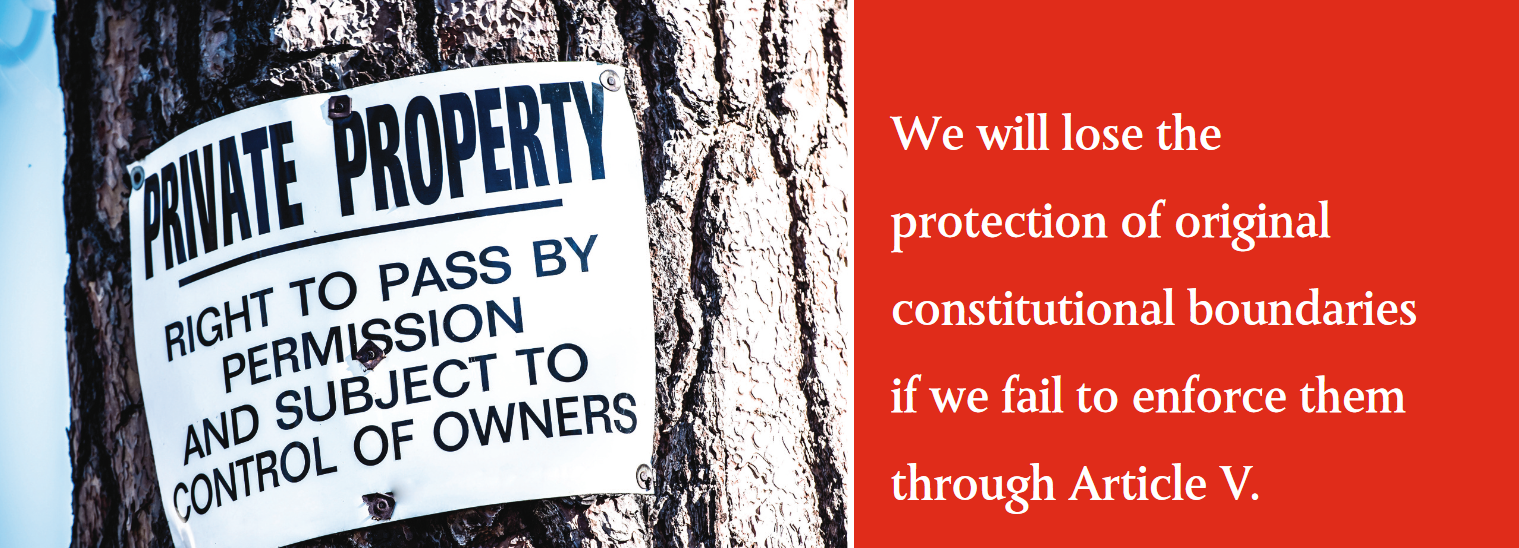
As a young lawyer fresh out of school, I often failed to question the judgments of more seasoned attorneys, always assuming they knew something I didn’t. I’m sure that was true enough, plenty of the time. But as time went on, I came to understand that often what seemed like a bad judgment call to me really was a bad judgment call. And it was my duty to point it out in the proper tone and forum.
Here’s what I’m getting at: The average American isn’t so ignorant, nor the average judge, congressman, president, or bureaucrat so brilliant, as we might think. The Constitution is for us, and it is not so complex that we should despair of under-standing it.
When our government’s “interpretations” of the Constitution don’t seem to square with what we read in black and white, it is usually because they don’t square with the Constitution, and our President, Congress, courts, and countless busy bureaucrats are really acting without proper constitutional authority.
The feds have rudely pitched their tent on the front lawn of our liberty, and it’s time we served them their eviction notice.
Just as landowners have the right and duty to invoke a legal process (eviction) to deal with squatters in property cases, the American people have the right and duty to invoke a particular constitutional process to restore the balance of power among the national government, the states, and the people. It’s found in Article V of the Constitution, and it’s called a Convention of States for proposing amendments.
But here’s the rub: Just as legal property owners lose their title if they fail to act, so we will lose the protection of original constitutional boundaries if we fail to enforce them through Article V.
You don’t have to take my word for it. In a law review article published last year, Boston College Law School Assistant Professor Richard Albert explained:
“There are several other more flexible modes of constitutional change that do not rely on the mechanistic procedures of Article V in order to keep the constitutional regime current and reflective of the new social and political equilibria. They result in unwritten changes to the Constitution that may be as constraining as a formal amendment. That the United States Constitution is both written and unwritten is therefore now uncontroversial.”
What Albert describes as the “unwritten” Constitution, achieved by “more flexible modes of constitutional change,” is just like the “unwritten” legal title that squatters achieve when the rightful owner fails to defend his property. Ultimately, it comes to have the same force and effect as a written deed to the family farm.
Every student of American history knows that legitimate government depends upon the consent of the governed. The legal title to government is vested in us, and with it the right and duty to defend our title against trespassers.
I urge you to join with the Convention of States Project to evict the constitutional squatters.
Article 16 - Implement Tenth Amendment
The Article V Solution — The Way to Implement the Tenth Amendment
Rita Dunaway, Esq., National Legislative Strategist for the Convention of States Project
It’s the elephant in the room. The Tenth Amendment boldly declares:
“The powers not delegated to the United States by the Constitution, nor prohibited by it to the states, are reserved to the states respectively, or to the people.”
But if the daily news is any indication, there is no subject exempt from federal power. Through its power of the purse, which is virtually unlimited under the modern interpretation, Congress can impact, influence, or coerce behavior in nearly every aspect of life.
The question, then, that holds the key to unlocking our constitutional quandary, is this: How do states protect their reserved powers under the Tenth Amendment?
On a piecemeal basis, states can certainly challenge federal actions through lawsuits, arguing that the federal government lacks constitutional authority to act in a particular area. But what if the court, as it is wont to do, “interprets” the Constitution as providing the disputed authority? What then?
In their frustration and disbelief over the growing extent of federal abuses of power (and the refusal of our Supreme Court to correct them), some conservatives argue that states should engage in “nullification,” whereby the states simply refuse to comply with federal laws they deem unconstitutional.
While there are some, less dramatic forms of nullification that are perfectly appropriate and constitutional—such as
states refusing to accept federal funds that come attached to federal requirements—this state-by-state, ad hoc review of federal law is fraught with legal and practical pitfalls.
First of all, which state officer, institution, or individual decides whether a federal action is authorized under the Constitution? Is it the state supreme court, the legislature, the attorney general—or can any individual make the determination? After all, the Tenth Amendment reserves powers to individuals as well as to states.
Secondly, how can a state enforce its nullification of a federal law? For instance, if a state decides that the Affordable Care Act’s individual man-date is unconstitutional, how can it protect its citizens against the “tax” that will be levied against them if they fail to comply? It’s difficult to envision an effective nullification enforcement method that doesn’t end, at some point, with armed conflict.
But for true conservatives whose goal is to conserve the original design of our federal system, the far more fundamental problem with this type of in-your-face nullification is the fact that it was not the Founders’ plan.
Article VI tells us that the Constitution, and federal laws passed pursuant to it, is the “supreme law of the land.” Under Article III, the United States Supreme Court is considered to be the final interpreter of the Constitution. While some claim that this was not the Founders’ intention, historical records such as Alexander Hamilton’s Federalist 78 demonstrate it was, in fact, the judiciary that they intended to assess the constitutionality of legislative acts.
And then we have the Tenth Amendment itself. It establishes a principle, but it does not establish a remedy or process for protecting the reserved powers from federal intrusion.
That missing process is found in Article V. Faced with a federal government acting beyond the scope of its legitimate powers—and a Supreme Court that adopts erroneous interpretations of the Constitution to justify the federal over-reach—the states’ constitutional remedy is to amend the Constitution to clarify the meaning of the clauses that have been perverted. In this way, the states can assert their authority to close the loopholes the Supreme Court has opened.
You don’t have to take my word for it.
In an 1830 letter to Edward Everett, James Madison wrote:
“Should the provisions of the Constitution as here reviewed be found not to secure the Govt. & rights of the States agst. usurpations & abuses on the part of the U.S. the final resort within the purview of the Constn. lies in an amendment of the Constn. according to a process applicable by the States.”
In other words, Article V is the ultimate nullification procedure. For states that have the will to stand up and assert their Tenth Amendment rights, they can do so by applying for an Article V convention to propose amendments that restrain federal power.
Originally published on TheBlaze.com
Article 17 - Address State Budget Challenges
How Can the Convention of States Project Help Address My State’s Budget Challenges?
Vickie Deppe, Illinois Legislative Liaison, Convention of States Project
Is your state a “donor state?” Donor states are those in which taxpayers consistently pay significantly more to the federal government in tax payments than their state receives in federal spending. California, Colorado, Delaware, Illinois, Kansas, Massachusetts, Minnesota, Nebraska, New Jersey, New York, and Ohio are consistently among the biggest losers when it comes to the federal budgeting process. All of these states each lost over $10 billion (some of them several times that) to other states in 2014 alone. Even tiny Delaware sent $13 billion to other states, courtesy of the federal government.
Here in my home state of Illinois, our budget situation is so precarious that our comptroller made national news by suspending payments to lottery winners. If we could keep even half of the $78 billion we lost in 2014 here in Illinois, we could immediately close our budget gap and begin catching up on our under-funded pension obligations…without having to raise anyone’s taxes.
How is this money collected, and where does it go? The money that goes to Washington gets there through a variety of taxes, some obvious and some less so. Personal income tax is one of the primary vehicles for the transfer of money from the states to Washington. Estate and inheritance taxes, gift taxes, and taxes, such as the FICA match, paid by employers are also part of the formula. Money returns to the states through a wide array of federal programs and expenditures such as highway funding, social safety net programs, military spending…and pork.
Here are just a few of the more egregious examples of federal waste, fraud, and abuse:
- $150,000 to study the hookah smoking habits of Jordanian students
- $121 million on lavish conferences for Department of Justice employees
- $1 billion on energy credits for people who don’t own any real estate
- $24 million on routers powerful enough to serve thousands of users for buildings in rural West Virginia with fewer than 10 computers
- $104 million on a “Harbor to Nowhere”and “Airport to Nowhere” to go with Alaska’s “Bridge to Nowhere”
- $2 million to fund a single intern for the Department of Agriculture
- $862,000 a year to warehouse unused furniture for the IRS
- $16 million a year on food stamps for dead people
These expenditures are easily hidden in the federal budget because it is so large and complicated. Together with the annotations, the federal budget is the size of a telephone directory for a large city. Unless they sit on an appropriations committee, members of Congress can only cast an up or down vote on a budget or spending bill in its entirety. Most of them can’t possibly read it all, and even if they did, they have no power to strike a single line item. And they certainly aren’t going to bring the entire federal government to a halt over a little pork…especially if their state benefits. But as Sen. Everett Dirksen famously said, “A billion here, a billion there, and pretty soon you’re talking about real money!”
Do you think you could manage this money better? So do the staff, volunteers, and supporters of the Convention of States Project. We believe that the best decisions are made as close to home as possible, with local input and oversight. The challenges facing cities like Chicago and New York are far different from those in Antelope, South Dakota. The needs of an individual community, big or small, shouldn’t be drowned out in a one-size-fits-all “solution” crafted largely by people who have never even set foot in that neighbor-hood…or one in which waste, fraud, and abuse is an inherent part of the system.
At an Article V Convention to limit the power and jurisdiction of the federal government and establish spending controls and term limits upon its officials, the states have the power to propose a constitutional amendment that prohibits the federal government from spending money on projects and expenditures that the Constitution originally reserved for state and local control. They can also eliminate unfunded federal mandates.
And if you’re a legislator in a donor state, that’s very good news.
Article 20 - Necessary Proper Clause
The Necessary and Proper Clause Does NOT Empower Congress to Control an Amendments Convention
Robert Natelson, Independence Institute’s Senior Fellow in Constitutional Jurisprudence and Head of the Institute’s Article V Information Center
A few days ago I heard a presentation by a spokesman for a group that claims to defend the Constitution and revere the Founders. Yet the spokesman trashed the Constitution’s Framers for allegedly exceeding their authority and claimed they added a provision that largely rendered another provision useless. In other words, the spokesman charged the Framers with being both (1) dishonorable and (2) incompetent.
The Framers inserted the “Convention for proposing Amendments” in the Constitution to provide the states with a way of obtaining constitutional amendments without federal interference. Tench Coxe, a leading advocate for the Constitution during the ratification debates, pointed out that the convention device allows the states to obtain whatever amendments they choose, “although the President, Senate and Federal House of Representatives should be unanimously opposed to each and all of them.”
The spokesman, however, asserted that the Constitution allowed Congress, through the Necessary and Proper Clause, to dictate, either in the convention call or by previous legislation, how an amendments convention is structured and how commissioners (delegates) are selected and apportioned.
The claim that Congress can use the Necessary and Proper Clause to structure the convention was first advanced in the 1960s, and has been repeated numerous times since then. A Congressional Research Service report published earlier this year noted that some in Congress have taken the same line, although the report did not actually endorse it.
But pause to consider: Why would the Framers place in the Constitution a method by which Congress could largely control a convention created to bypass Congress? Were the Framers that stupid?
Of course not. Most of them were highly experienced and extremely deft legal drafters.
Behind the belief that the Necessary and Proper Clause empowers Congress to structure the convention are three distinct assumptions—all
erroneous. They are (1) that the scope of Congress’s authority under the Necessary and Proper Clause is broader than it is, (2) that the Clause covers the amendment process, and (3) that ordinary legislation may govern the amendment process.
The Necessary and Proper Clause is the last item in the Article I, Section 8 list of congressional powers. It reads:
“The Congress shall have Power . . . To make all Laws which shall be necessary and proper for carrying into Execution the foregoing Powers, and all other Powers vested by this Constitution in the Government of the United States, or in any Department or Officer thereof.”
It happens that the most extensive treatment of the Necessary and Proper Clause is an academic book I co-authored with Professors Gary Lawson, Guy Seidman, and Geoff Miller: The Origins ofthe Necessary and Proper Clause (Cambridge University Press, 2010) (cited by Justice Thomas in a Supreme Court case in 2014 and apparently relied on by Chief Justice Roberts in 2012). This book reveals the Necessary and Proper Clause to be a masterpiece of legal draftsmanship.
The Clause was based on usage common in 18th-century legal documents. It is not a grant of authority, but a rule of interpretation. It tells us to construe certain enumerated powers as the ratifiers understood them, rather than in an overly-narrow way. In legal terms, the Necessary and Proper Clause informs us that those enumerated powers include “incidental” authority.
Even if the Clause did apply to the amendment process, the authority “incidental” to Congress’s call would be quite narrow. An entity that calls an interstate convention always has been limited to specifying the time, place, and subject matter. It is the state legislatures that control selection of their own commissioners.
But, in fact, the Necessary and Proper Clause does not extend to the amendment process. To explain:
The Constitution includes numerous grants of power. These grants are made to Congress, to the President, to the courts, to the Electoral College, and to state legislatures, state governors, and various conventions. An entity exercising a power under one of those grants is said to exercise a “federal function.”
The Necessary and Proper Clause is crafted to apply to most federal functions, but it also excludes a number of them. Specifically, it covers only the grants listed in Article I, Section 8, and those vested in the “Government of the United States” and in “Departments” and “Officers” of that government.
In other words, the Clause omits constitutional grants made to entities that are not part of the “Government of the United States,” even when those entities exercise “federal functions.” See, for example, Ray v. Blair, 343 U.S. 214 (1952) (holding that presidential electors, who ultimately derive their power from the Constitution, exercise a federal function but are not federal officers or agents). The convention for proposing amendments is one of a handful of entities that falls into this category.
Even if we did assume, for sake of argument, that Congress is a “Department” of the federal government for other purposes, the rules for Article V are different.
The difference is that (according to the courts) when Congress and state legislatures act in the amendment process, they do not act as the legislative branches of their respective governments. Instead, they act as ad hoc assemblies for registering the popular will. They can exercise only the power granted by Article V, and not powers granted by other parts of the U.S. Constitution or by state constitutions. Thus, in Idaho v.Freeman (1981), a federal court ruled that:
“Congress, outside the authority granted by Article V, has no power to act with regard to an amendment, i.e., it does not retain any of its traditional authority vested in it by Article I” [which includes the Necessary and Proper Clause].
(This case was later vacated as moot, but there were no problems with the merits of the ruling.) Or, as the Supreme Court of Missouri pointed out when addressing the state legislature’s Article V functions, “[The legislature] was not, strictly speaking, performing the functions of a legislative body for the state, but was acting as a representative of the people, pursuant to authority delegated to it by the federal Constitution. . . ” State ex rel. Tate v. Sevier (1933).
(The U.S. Supreme Court denied certiorari in that case, meaning it refused to consider reversing this decision.)
Again, when legislatures act under Article V they do so as separate assemblies, not as the legislative branches of their governments. This is a very old principle, dating back to 1798, when the Supreme Court held that congressional amendment proposals do not need presidential signature. See also United States v. Sprague (1931).
Well, if Congress cannot insert language in the “call” structuring the convention, can it pass laws for the same purpose? Again, the answer is “no.” A long list of 20th century cases from courts at all levels holds that the amendment process is governed by the express and implied provisions of Article V, not by other sources of law, such as statutes, state constitutions, or ordinary legislative rules. See, for example, Leser v. Garnett (1922) and Dyer v. Blair (1975).
Article 21 - John Birch Society
The John Birch Society Denies Its History and Betrays Its Mission
Ken Quinn, Convention of States Project
For decades The John Birch Society (JBS) has been using fear tactics to manipulate state legislators into believing that an Article V convention for proposing amendments is a Constitutional Convention. To further their agenda they make the false claim that the 1787 Constitutional Convention was called by Congress to solely revise the Articles of Confederation and that the convention “ran away” because the delegates wrote an entirely new Constitution instead.
These claims are false and have been refuted by historical facts and even the writings of the Framers themselves (see “Can We Trust The Constitution,” by Michael Farris, and Federalist 40, written by James Madison).
This marketing campaign of fear titled “Stop a Con-Con” has silenced the voice of the people and has paralyzed some state legislatures from fulfilling their duty as the barrier against encroachments by the national government (see Federalist 85).
Instead of supporting the states in their efforts to fight back against an overreaching federal government, JBS has actually helped the federal government to go unchecked by preventing the states from using the very tool the Framers provided to stop such usurpation of power.
The John Birch Society claims to be for “less government and more responsibility,” yet when state legislatures try to pass resolutions to actually propose such amendments, JBS actively opposes them and even works to rescind resolutions that have passed!
According to JBS President John McManus, it does not matter what amendment is being advocated by the states; they will oppose it regardless of the topic. JBS works to rescind resolutions even for amendments that they claim they would like to see proposed by Congress, such as repeal of the Seventeenth Amendment (direct election of senators) and the Sixteenth Amendment (federal income tax).
McManus states that only Congress should be allowed to propose amendments to the Constitution. Stop and consider that for a minute. He is actually trying to convince his membership and you as state legislators that those who are daily usurping the Constitution are the only ones who can be trusted to propose amendments to it! Does anyone truly believe that Congress will propose amendments to limit their own power? Of course not!
You see, JBS does not trust you as a state legislator or the people to govern themselves. Does that sound like an organization that supports “less government and more responsibility” to you? JBS will give lip service to the Constitution, but when it comes to the states actually trying to use the Constitution to defend themselves as intended by the Framers, JBS is anti-Constitutional.
However, former JBS leaders were strong supporters of the states calling for an Article V convention for proposing amendments. As you are about to see, they not only understood Article V but they fully advocated for the states to hold a convention to propose an amendment that would fulfill their goal of “less government and more responsibility.” That amendment was known as the Liberty Amendment.
In 1944, Willis E. Stone, a descendant of Thomas Stone, a signer of the Declaration of Independence, drafted the Liberty Amendment, which sought to vastly restrict federal authority, cut government cost, protect private enterprises, and repeal the Sixteenth Amendment. Stone ultimately organized the Liberty Amendment Committee in all 50 states and worked for decades to have his amendment proposed either by Congress or by the states in an Article V convention.
Shortly after JBS was founded in 1958 by Robert Welch, JBS members began supporting state legislatures in their efforts to pass resolutions for the Liberty Amendment.
As one newspaper reported, “Members of the four Birch societies in Bismarck, the state capital [of North Dakota], were pushing in the legislature a proposal for a constitutional convention to act on an amendment…[the Liberty Amendment].” 1)
In August of 1963, Welch sent an urgent request asking all JBS chapter leaders and members to send telegrams and letters urging the Alabama Senate to pass the resolution calling for the Liberty Amendment. 2)
Welch also produced a 15-minute radio program for JBS called “Are You Listening Uncle Sam,” and, in 1967, he dedicated two programs to the Liberty Amendment. On the program Stone explained that his organization was using both methods (Congress and an Article V convention) to propose the Liberty Amendment.
In 1967 California State Senator John Schmitz, who was also a National Director for the John Birch Society, introduced the Liberty Amendment and called for a “national convention.” 3)
In 1968 Welch joined Senator Schmitz as special guests at the National Convention of the Liberty Amendment Committee. 4)
Obviously, Welch supported Stone’s efforts to have either Congress or the states propose the Liberty Amendment, and he used his time, resources, and relationships to make it happen.
On October 9, 1975, Representative Larry McDonald from Georgia, who served at the time on the John Birch Society’s National Council, introduced the Liberty Amendment in Congress and gave extensive testimony — including advocating for the states to propose it in an Article V convention. 5)
In his book titled “We Hold These Truths,” Representative Larry McDonald accurately explains that Congress and the states are authorized to propose amendments:
“Congress is authorized to propose constitutional amendments if it pleases. It is obligated to call a special convention to propose constitutional amendments if two-thirds of all state legislatures demand that it do so.”
Nowhere in the writings of Welch or McDonald do you find them concerned about a “runaway convention” or that the entire Constitution could be thrown out in an Article V convention. In fact, they were one hundred percent behind the states in their efforts to use Article V to propose amendments.
It is only under the current leadership of JBS that this organization has turned its back on the Constitution and the process the Framers gave us to defend our security and liberties. In so doing, The John Birch Society has denied its history and betrayed its mission.
In fact, in his article, “Falsehoods Mark the Campaign for a Constitutional Convention,” McManus denies all of the evidence to the contrary. Though a “constitutional convention” is not the same thing as an Article V convention for proposing amendments, McManus and other current JBS leaders insist upon referring to an Article V convention of states as a “constitutional convention.” If the President of JBS is this misleading about the history of his own organization, why would anyone in his right mind trust him in regards to the history of our Constitution?
The time has arrived for our state legislatures to stop falling victim to the fear-mongering tactics and conspiracy theories of extremist groups. As representatives of the people and guardians of the Republic, you are the last resort in defending us against this overreaching federal government by proposing amendments to restore the balance of power back to the states.
Time is running out. Will you be led by fear or will you be a fearless leader?
Article 22 - Article V Process
The Process of an Article V Convention For Proposing Amendments
34 STATE LEGISLATURES APPLY FOR A CONVENTION TO PROPOSE AMENDMENTS ON A SPECIFIED TOPIC
- The topics specified in the applications must be the same, in order for them to aggregate.
- The topics in the aggregated applications set the agenda for the Article V Convention.

CONGRESS “CALLS” THE ARTICLE V CONVENTION, BY SETTING THE TIME AND PLACE
- The entity that “calls” the meeting does not exercise any authority other than setting the time and place.
- Issuing the call is a ministerial duty.

THE STATES SELECT, INSTRUCT, AND SEND DELEGATES TO THE AMENDMENT-PROPOSING CONVENTION
- All states can participate, even those that did not apply.
- States select the delegates who will act as their agents at the convention, and instruct them on the scope of their authority.

CONVENTION OCCURS.
PROPOSED AMENDMENTS SUPPORTED BY THE MAJORITY OF
STATE DELEGATIONS ARE SENT TO THE STATES FOR RATIFICATION.
- States may send as many delegates as they choose, but each state only gets one vote when the convention begins.

CONGRESS SELECTS THE METHOD OF STATE RATIFICATION
- By the specific terms of Article V, Congress must choose between two options for state ratification: ratification by state legislatures or by state ratifying conventions.

PROPOSED AMENDMENTS ONLY BECOME EFFECTIVE IF RATIFIED BY 38 STATES
- It only takes 13 states to stop a bad amendment.
- By asserting your constitutional power under Article V, you can act as a final check on rampant federal overreach, and restore the proper balance of power.
The restrictions, limitations, and controls on the Article V process include all of the following, acting in conjunction:
- The convention’s agenda is set by the 34 state applications (for the Convention of States Project, amendment proposals must “impose fiscal restraints on the federal government, limit the power and jurisdiction of the federal government, and limit the terms of office for its officials and for members of Congress”);
- Once 34 states apply for a convention on the same topic and the convention is called, state legislatures select and instruct their delegates;
- At the convention, any single delegate can object to off-topic proposals as “out of order,” for which the objection must be sustained;
- At the convention, a majority of the states must vote in favor of any proposal in order for it to advance to the ratification stage;
- Any delegate who proposes or votes in favor of an amendment beyond the scope of the agreed agenda OR beyond the scope of his/her state legislature’s instructions can be recalled by the state legislature and subjected to penalties according to state law;
- Because delegates act as the agents of their state legislatures, a delegate's vote that exceeds his/her instructions or authority is void;
- The courts could be called upon, if needed, to protect the process at any point (there are abundant precedents demonstrating that, in fact, the courts DO acknowledge and protect the historical Article V procedures);
- 38 states must ratify any proposed amendments for them to become effective. This means that itonly takes 13 states to block a bad proposal.
Article 23 - Federal Control Lands
Public Lands: A “Generational Vision”
Ken Ivory is a Utah State Representative and Director of the Free The Lands Project with Federalism in Action.
As they moved westward, their strongest men inexplicably dropped dead along the trail. In a company of pioneers trudging forward through harsh, early winter conditions, the sudden deaths caused great concern. The company leader ordered an investigation.
The ones still alive were all half-frozen. As their supplies dwindled, their daily ration of food was one small, eight-ounce pouch of flour. These strong men were scooping much of their flour into their children’s pouches so that they might make it safely to their land of promise.
The hardships these pioneers endured paled in comparison to their vision to secure their own piece of land and the right to govern themselves, and to pass on to their children the opportunity to prosper.
The movie “Monumental” depicts how the pilgrims suffered intensely during their first winter. Nevertheless, the sickly settlers refused to give up and sail back to England, having a “generational vision that they could lay their lives down in this wilderness and literally put their faces down in the mud and have their children walk on their backs to a better day.”
Aren’t we all pioneers and pilgrims? Don’t we all share the same “generational vision” of healthier air, water and wildlife; safe and vibrant communities; and abundant recreation?
We’ve been told for decades now that, to achieve this promise, we have to trust distant federal bureaucrats with the management of our unique lands. However, federal bureaucrats, more concerned with policies than promises, lock up our lands like they are in a museum — Hands Off, Don’t Touch!
This “museum management” results in overgrown forests and record-setting catastrophic wildfires that pollute our air, destroy water supplies and habitat, and kill wildlife in the millions, leaving communities depressed and unsafe, and recreation areas burned up or blocked off. It’s Not Working!
It’s not working for the Oregon woman who was raped and brutalized in her own home because federal policies shut down the timber industry that funded the sheriff’s department. When she called 911, all the operator could do was to tell her to “call back tomorrow” because, with only two deputies, the sheriff’s office could not respond.
It’s not working for the little bear cub in eastern Washington state who crawled desperately on her little paws, burned up to her elbows, to find anywhere that was not an inferno. State wildlife agents found her and she was nursed to health, only to be released into another overgrown forest. Every year, millions of her forest mates are not so lucky.
It’s not working for the lands and people of Montana. Firefighters in the state put out wildfires, on average, at less than 10 acres. Their helicopters are equipped to carry more water and drop it faster. When wild-fires broke out on federal lands, five Montana crews were in the air. However, the U.S. Forest Service grounded them because the Montana helicopters were “not on their approved list.” The Montana crews sat there on the ground watching thou-sands upon thousands of acres burn, their air polluted for weeks, and their water sup-plies decimated.
It’s not working for Garfield County, Utah, where they recently declared an economic state of emergency. Inflicted by a host of federal lands policies, from a two million-acre national monument that shut down the world’s largest reserve of the cleanest coal, to federal policies that decimated their timber and livestock industries, the number one export from Garfield County is now their children.
It’s not working for national security or energy independence. China controls nearly 90% of the world market for rare earth elements that are vital to the technology that keeps our planes in the air, ships on the water, and troops on the field. We have rare earth elements in abundance locked up from New Mexico to Alaska in federally controlled lands. We are dependent on foreign powers that manipulate the price and supply of our energy. According to the U.S. GAO, there is more recoverable oil in Utah, Colorado, and Wyoming than in the rest of the world combined, locked up in federally controlled lands.
It’s not working for the nation. The federal government extracts billions of dollars each year from taxpayers east of the Rockies, to subsidize western communities that are thwarted in their ability to raise sufficient revenues for public services because the federal government controls up to 90% of their lands. Worse yet, Congress regularly holds these funds to western communities hostage in a sort of “two-bit protection racket,” as Sen. Mike Lee calls it, to garner western votes for hundreds of billions to be doled out from the “dysfunctional favor bank” that epitomizes D.C. politics. This undermines our system of strong, self-reliant states meant to check federal overreach.
So, what’s the answer? Have you ever had a garden? If so, you know that a healthy garden is a productive garden, and a productive garden is a healthy garden. Who better to tend the garden than those who know the unique soil, climate, pests, and local conditions best, and who are on hand to address the unforeseen circumstances that always arise?
It’s time to Free the Lands for more effective local care and management. Who better to care for the unique lands and interests of Nevada (85% federally controlled) than Nevadans? Or, for the unique lands of Alaska (more than 225 million acres federally controlled) than Alaskans?
With the same “generational vision” that built this nation, we can secure the opportunity for our children to prosper.
A Convention of States has the power to propose amendments that will rein in an out-of-control federal land baron, transition to more effective local care of our unique lands, and unleash a national economic renaissance.
What’s in your flour pouch?




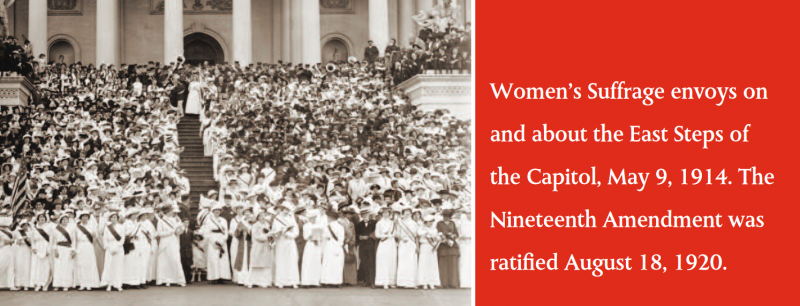

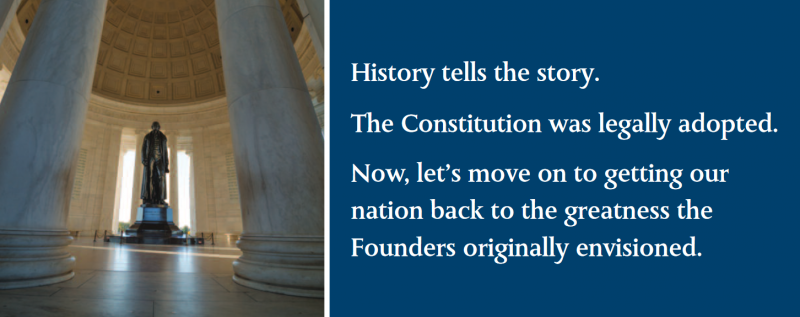



![One source of security we have... is the courts’ long history of protecting the integrity of the [amendment] procedure. One source of security we have... is the courts’ long history of protecting the integrity of the [amendment] procedure.](/lib/exe/fetch.php?w=800&tok=7c2192&media=documents:cosproject:surge:surge-6-1.png)
